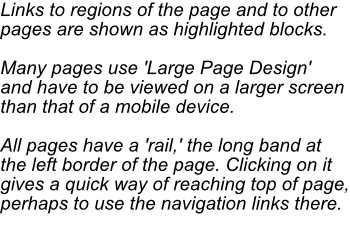
See also my page Poems
Introduction
Unit poetry and an exploding poem
The WW2 bombing campaign
Fragmented poetry
Strata poetry
Punctuation
Colour effects
Transept poetry
Axis poetry
Constellation poetry
'Anti-emoticons'
Concrete poetry: renewal of a neglected form
Introduction
Graphic
design, like other branches of design, is amongst other things the art of
placing: graphic design is the art of placing words and images (or only
words or only images) on a two dimensional surface (such as paper or a
computer screen) to produce a desired effect with as much effectiveness as
possible. The desired effect includes these: to persuade (for example to
bring about a political choice or a consumer choice, such as to buy
something) or to inspire (in the common routine meaning of the word or a
better meaning), to convey beauty or to convey harshness - this is a world
which contains both beauty and harshness, of course, as well as so many
other strongly marked contrasts.
The art of concrete poetry, and the
world of concrete poetics, is likely to be unfamiliar to most graphic
designers, but I'd claim that graphic designers would benefit by studying
the subject - if the demands on their time allow. The fields of graphic
design and concrete poetics overlap to a very great extent - the linkages
between them are very considerable, even if the contrasts are striking.
Amongst the contrasts are these: the desired effect of concrete poetics
hasn't so far included advertising of products and isn't likely to in the
future. Concrete poetics rarely includes images, although some of my
concrete poems do. But concrete poetry uses the placing of words on a page
(paper page or computer page or 'page' made of stone or other materials) to
convey an image, explicitly or implicitly. Amongst the linkages between
graphic design and concrete poetics: concrete poetry, like graphic design,
can convey a very wide variety of emotional states and responses to the
world, including the world of human experience, including beauty and harshness.
Unit poetry and an exploding poem
Unit form is a particularly demanding and difficult concrete
form. In the version I mainly
use, the 'units' are letters, punctuation marks and spaces. By controlling
the units in each line, the poem can be shaped exactly.
This poem has an
augmented half and diminished half. In the augmented half, the lines
increase by three units from line to line - 45 units in the 1st line, 48 in
the 2nd and 51 in the 3rd. In the diminished half, lines decrease by 3
units. This static version shows the organization clearly:

The poem is about the
collision of two Lancaster bombers over Cologne. The section The
WW2 bombing campaign gives supplementary
information about the British bombing offensive against Germany during the
Second World War.
For unit poetry, a font is used which, like a typewriter
font, is not based on proportional spacing, with characters of variable width.
The font used in 'Collision' is a monospaced font, Courier New. In this font,
all units are of equal width. The poems in this form were composed on graph
paper, initially.
Unit poetry gives the maximum contrast between text and the white space surrounding
the text. The white space between words is the absolute minimum.
As a result, the impact of the text is increased. Other forms of concrete
poetry usually give shape to the poem by increasing the space between words,
in other words, by allowing more white space into the text. This may be an
intrinsic part of the design or it may lessen the contrast between text and
the surrounding white space.
The poem in animated form is typed and then
destroyed by an explosion:
'Collision'
in its animated form could be considered as a contribution to 'Kinetic Art,'
art involving movement, which had its genesis in the Futurist Manifestos of
1909, 1910 and 1912. "In Kinetic Art the composition is not given all
at once." (C. Barrett, 'Kinetic Art' in 'Concepts of Modern Art,' edited
by Nikos Stangos.) The repeated construction and destruction in 'Collision'
could even illustrate Nietzsche's idea of 'the eternal recurrence,' the idea
that all events, the worst and most terrible as well as the best, are repeated
endlessly. "The idea of eternal recurrence, the highest formula
of affirmation that can possibly be attained" (Nietzsche, Ecce Homo,
'Thus Spoke Zarathustra 1) is stated in other places in Nietzsche's writings,
for example, 'Beyond Good and Evil,' Section 56 and various sections of 'Thus
Spoke Zarathustra' itself. But I don't accept the idea of the eternal recurrence
for one moment - who could?
This
in another poem in unit form, 'Level Crossing:'
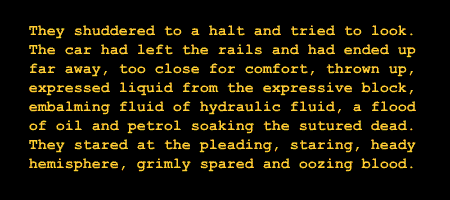
The poem is about a car which is hit by a train and converted into a block
of scrap metal. This is a representational unit poem. The poem is a block
itself. Each line is exactly 43 units long. I'm conscious that this poem,
in Keats's phrase, doesn't make "all disagreeables evaporate." A
poet's work as a whole should have this effect but a single poem can show
untransformed horror, can express an unrelievedly bleak vision. Besides, the
repulsive content of the poem is not all. It's in tension with the serene
and harmonious shape of the poem.
The Peruvian poet Cesar
Vallejo's wrote in Poem XXVI of 'Trilce:'
Rehusad, y vosotros, aposar las plantas
en la seguridad dupla de la Armonia.
Rehusad la simetria a buen seguro.
Refuse to place your footsteps
in the double security of Harmony.
Refuse to allow symmetry to
make you sure.
but
in my 'symmetrical' poems' I'm doing something unexpected and, I think, well
worth doing: using serene, symmetrical shapes in tension with disharmonious
content. Mathematicians and scientists take an interest in symmetry. I think
poets can take some interest in symmetry too, as an instance of pattern. There's
the maximum of tension between the harmonious shape and the
bleak and discordant content. This is an aspect of what I call tensile
art. In general, in the face of opposites, poetry which is distinctively
modern will not reject one of them but will tend to affirm both, often precariously,
with great tension. The poets of the past who seem most modern to us have
done exactly this: Catullus, for example, with his 'Odi et amo,' 'I hate and
love.'
The
next unit poem is even more exacting in its form than the previous poems.
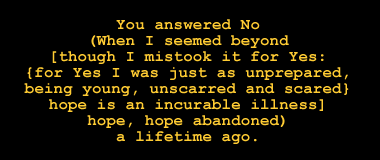
This is a poem in
centred
rhyme, the first line rhyming with the last, the second line
rhyming with the penultimate, and so on. The first line has exactly the same
number of units - characters, punctuation marks and spaces- as the last (15)
the second, which is longer, has exactly the same number of units as the next
to the last (21) and so on. The lines are linked by sound, linked by length
and linked by completion - the later line completes the earlier. The symmetrical
poem expands and then contracts - the lines are augmented and diminished.
The
poem is fictional: it doesn't refer to any experiences of
my own. If a prose writer uses 'I' it's recognized that the reference may
be fictional or non-fictional and no insincerity is intended if the reference
is fictional. It has come to be assumed that if 'I' is used in poetry, the
writer is referring to his or her own experiences, thoughts, feelings. The
title of the poem is 'a refusal to enter into a relationship' so the 'No'
is to be interpreted in those terms.
The
poem is 'nested,' there are brackets within brackets within brackets, so it
will give an impression of dislocation when it's spoken. (For a discussion
of parentheses in poetry see 'But I digress: the exploitation of parentheses
in English printed verse' by John Lennard, 1991.) On the other hand, the poem
on the page will give an impression of harmonious, rational procedure. As
in the case of the other unit poems above, the poem on the page and the spoken
poem are very different in kind.
The
fact that life can contain such extreme contrasts I express in a poem which
is not in concrete form:
Your life,
full of chance and finalities,
can have the smiling assurance
of someone who never thinks.
Be like nature,.
which accompanies wars and killings,
its own discreet or dramatic killings,
with snow settling, winds blowing,
the moon rising or setting with such simplicity,
on such carnage.
Be happy, be contented, be unsatisfied, be many.
Feel the ecstasy of the hunter,
the terror of the hunted,
the anger of the one who acts to stop the killing -
but of course, so rarely can.
My
view is far removed from Nietzsche's. I regard Nietzsche as almost a low-tension
thinker. A low-tension thinker can't keep opposed ideas in consciousness
simultaneously, but has to emphasize one whilst denying others. There's a
low-tension view which cannot come to terms with the shocking aspects of reality
but instead distorts reality by, for example, sentimentalizing it. Nietzsche
could keep the two ideas in consciousness at once, the harshness of reality
and its wonder. However, he refused to acknowledge one more strand which can't
be wished away without distorting reality, or so I claim: active humanitarianism,
the urge to reduce suffering, to improve the world, an attempt which will
often be frustrated ("...the anger of the one who acts to stop the killing,/but
of course, so rarely can") but which is not always frustrated, an attempt
which is difficult and sometimes impossible but absolutely essential. This
is a high-tension view.
The
Matterhorn

Why,
Whymper,
will we wish
we were where we
'whither?' wondering
why Waste weeds windowed
Will worn well-welter-white?
The number of units - letters, spaces and punctuation
marks - decreases by four from one line to the next, giving the poem the approximately
triangular shape of the Matterhorn, viewed from Zermatt.
Edward Whymper:
the mountaineer who took part in the first ascent of the Matterhorn in the
Alps. Four of the mountaineers who climbed with him fell down the North
face and were killed. (More has been written about this tragedy in mountaineering
history than any other.)
In addition to the opening word of the single sentence, 'Why,' nouns are capitalized
- 'Waste weeds' has a different meaning from 'waste Weeds.'
The poem is about the wish to be in a place which is dangerous but significant.
The reality is of harshness which undermines illusions.
'whither' is used as a verb, and means here 'when we wonder what direction
to take,' and in particular the very many decisions as to direction on an
extended climb.
'windowed' refers to the use of 'window' by British bombers in The Second
World War,' strips of aluminium foil which confused German radar. Here, the
snow, a confused and confusing white, a 'welter,' is disorientating. 'White'
is also a colour appropriate to 'fright.' 'windowed' has a secondary meaning-linkage
here with 'defenestrated.'
The poem uses sound-linkage,
in this case alliteration, to an unusual extent, since every word begins with
'w' after the title. The 'Why' of the first line and the 'white' of the last
line are linked by non-initial sound as well. The sound-linkages here have
an interval of 7.
The
next poem is representational, with a shape lacking the serenity of the other
unit poems. The units can easily be counted here: exactly five in each line
and all of them letters.

The
poem is very much one for performance as well as visual display: performance
which begins and continues for some time with a pounding rhythm. A drum could
be used in performance or failing that hammered bass notes of a piano. The
driving rhythm doesn't continue throughout. There's a natural pause at the
end of the line 'flail' (line 16) and another pause at the end of the line
'flood' (line 24).
The
dynamics should be very loud to begin with but gradually softer with repetition
of the word 'dying,' until the word has something of the effect of the 'dying,
dying' in Benjamin Britten's 'Serenade for tenor, horn and strings, Op. 31
- it would be impossible to approach its wonderful evocation at all closely
- the decrescendo continuing so that the last few lines are hushed and very
quiet. In performance the poem begins very rapidly but becomes slower and
slower. Alternatively, readers can act like accomplished readers of musical
scores, hearing the sounds inwardly.
The units can take other forms. In this short poem, the units which are
controlled are consonants and vowels. There are 4 of these units in each
line, with varying numbers of punctuation marks. The units are shown here in
bold print and the punctuation marks in faint print. The vowels follow the
sequence a, e, i, o, u and the only consonants are an initial 'l' and final
't s,' or the same consonants with {reversal}. 'List' has multiple
ambiguities - the ambiguity of noun or verb, and ambiguities of meaning. It refers to leaning on
one side, the list which is an item-by-item record (only the beginning of
the list, the first item being 'lost lust'), and the archaic / poetic word
for 'listen:' 'listen to this ... '
Last:
'Let's ... !'
list ...
lost
lust
The WW2 bombing campaign
This section gives supplementary information about
the British bombing campaign during the Second World War, as background to the
first poem on this page, 'Collision.'
Below, the Lancaster of the Battle of Britain memorial
flight at RAF Wickenby, one of only two airworthy Lancasters left (the
other is in Canada.)
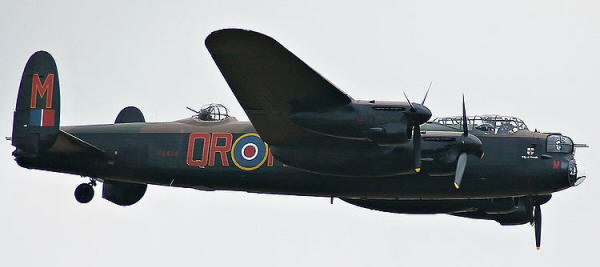
Below, Lancaster over Hamburg:
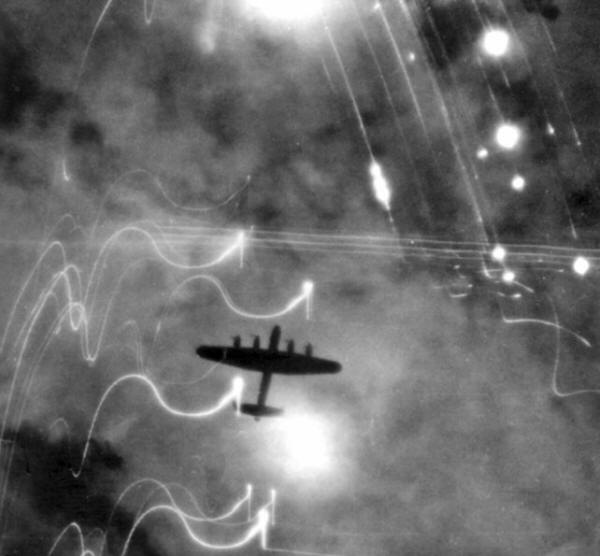
During the Second World War, 7 377 Lancasters were built.
3 249 were lost in action. 487 were destroyed or damaged while on the
ground. Only 24 Lancasters completed more than 100 missions. 55 573 aircrew
of bomber command were killed - not far short of half the total
number.
From
Max Hasting's account in 'Bomber Command' of the the first attack on Cologne, in May 1942, when
for the first time more than 1 000 aircraft took part:
'At
briefing, when the CO [Commanding Officer] announced that there would be more
than a thousand aircraft over the target, there was a moment of awed silence.
They were alarmed by the prospect of collision, but they were told that Bomber
Command's operational research scientists had computed that statistically
there should be no more than two aircraft colliding in the target area ...
Then they walked out into the dusk of a beautiful summer evening, and took
off through clear skies for Cologne.
'
... on the night of 30 May, crews in the later waves crossed northern Germany
... unable to accept the reality of the vast red glow in the sky ahead of
them. Some crews thought that a great forest or heath must have caught fire,
others that the Germans had created an enormous dummy fire to draw the bombers.
Only as they drew near did they perceive the incredible truth, that this was
the city of Cologne, ablaze from end to end.
'Micky
Martin was due over target forty-five minutes after H-Hour. From miles away,
he could see the huge fires lighting the sky ahead, dwarfing the pathetic
flickers of flak and searchlights. Martin came in low at 4,000 feet, his crew
gazing on the glowing red core of the city, broken by the silver thread of
the Rhine, the shimmering white spangles of blazing incendiaries, the great
silhouette of the cathedral, its twin towers still lingering amidst the miles
of rubble around the Rhine bridge ... Three times Martin swung over Cologne
awed, like so many airmen than night, by the devastation below.'
W. G. Sebald gives the information
that 'at the end of the war ... there were 31.1 cubic metres of rubble for
everyone in Cologne.' (' ... and 42.8 cubic metres for every
inhabitant of Dresden ...')
My poem 'The Bombing of Dresden' is
very different from 'Collision' and not a concrete poem. I give it here
because I think it conveys the lurid, apocalyptic scenes in Dresden and
because I attempt to convey the moral complexities - which, emphatically,
don't in the least prove that the British were 'no better' than the Nazis,
or that the bomber crews were war criminals. Dresden, for all the beauty and
splendour of many of its buildings, was Nazi Dresden in the years before the
war and in the war years. There's no moral equivalence between the actions
of the Nazis and the actions taken to defeat the Nazis. The circumstances of
those who flew in the bombers and those who would call them 'war criminals'
are vastly different. The flight crews given their pre-flight briefing on
operations against Dresden knew that they might well not return, as so many
others had failed to return from operations, they were in no position to
decide the strategic, tactical - and ethical - issues. Their critics enjoy
advantages they never had. Nobody who reads their accounts could fairly
condemn them.
My poem 'The Bombing of Dresden' is a
non-concrete poem. At this
stage in the war, there was a Master Bomber who flew over the area and
dropped target indicators, intended to make the bombing more accurate. The
master bomber is piloting a Mosquito aircraft. The 'slim sticks' are
incendiary bombs. A well-known image shows a statue on the town hall above
the devastated city. I refer to this statue in the closing lines.
The Bombing of Dresden
A black presence flitting above
darkened eaves -
the Master Bomber's Mosquito
swooping on the Sportsplatz,
near which the Polish slave labourer
was hanged.
Those who watched now wait.
Waiting now are refugees, the
innocent and the depraved,
those who know, do not
want to know and do not know,
Jew-baiters, Jew-haters, denouncers,
informers, children,
accomplices in mass murder, children.
The calm red glow of marker flares.
A call.
The opening of bomb doors, a steady
drone, the first screams.
Bodies blasted like quarry stone,
windows gouged out, everywhere roofs
collapsing,
everywhere worlds collapsing, the
crushing of hope.
The slopping of waste in cellars,
the fall of sinister slim sticks.
Fires licking eagerly, coupling,
becoming one.
Tongues of fire, rivulets of fire,
rivers of fire
bursting their banks and flooding
the town.
The first thousand now dead,
and the second and the third and the
fourth,
and perhaps the fortieth
deep in fumes or fire,
bodies sucked into incandescence by
an unnatural wind,
like minds sucked into the void of
the Reich.
And watching over all
the sparks of life and the crooked
timber's glow,
from a
great height,
a statue of stone.
Frederick Taylor writes in his book 'Dresden:'
'It became fashionable among writers
in the postwar period to dismiss city bombing, not only as immoral but also
as essentially useless. There seems, however, little doubt that the
strategic bombing campaign played a major role in the defeat of Germany (if
not perhaps the 'knockout' one that Sir Arthur Harris and his supporters
dreamed of), and growing evidence that it may even have proved decisive.
Early postwar surveys made the mistake of confining cost-benefit analysis to
a kind of simple accounting of notionally lost German production.
...
'More recent studies, especially
those of Professor Richard Overy, have taken a broader view and also incuded
the massive financial and material costs involved for the Reich in creating
a complex and sophisticated aircraft tracking and air defense system, in
rebuilding and relocating industrial and military installations, and in
feeding, housing and caring for victims of the escalating Allied bombing.
This not only took weapons and equipment from the frontline land troops, but
also vastly reduced the number of offensive aircraft available on all
fronts, especially in Russia.'
John Nichol and Tony Rennell, in the
book recommended below:
'Dresden may not have had the
obvious heavy, smokestack industries of the Ruhr but it did house the sort
of precision engineering demanded by new weapons technology. The city's own
description of itself proclaimed what was beneath the surface. Its yearbook
for 1942 boasted: 'Anyone ho knows Dresden only as a cultural city, with its
immortal architectural monuments and unique landscape, would be very
surprised to be made aware the extensive and versatile industrial activity
that make Dresden one of the foremost industrial locations of the
Reich.' The city had 127 factories which purported to be turning out
consumer goods and luxury items but which had secretly switched to war work.
Zeiss, the biggest manufacturer, had long ceased making cameras for tourists
in favour of bomb-aiming apparatus and time-fuses. A onetime manufacturer of
typewriters and sewing machines was turning out armaments. Dresden china
figures - for which the city was famous - were actually manufactured at
Meissen, twelve miles down the River Elbe, and the workshops there had also
been switched to war work and were turning out communications equipment for
the army. A company which had once made waffle and marzipan machines was
producing torpedo parts for the navy. Even an arts and crafts workshop was
producing wooden tail assemblies for V-1 flying bombs. Machine guns,
searchlights, aircraft parts, field telephones, two-way radios were just a
few of the other war goods being made there.
' ... The German High Command had
designated it as a military strongpoint, part of the defensive line along
the River Elbe at which the Soviet advance could be held. The order from
Berlin was that it was to be defended at all costs. So 'peaceful' Dresden
was in reality a war factory and a fortress, and these factors alone made it
a legitimate target for the bombers. But it was also a vital link in the
German rail network, and it is this that probably sealed its fate. It was a
cross-roads for north-south and east-west traffic.'
The aircrew about to face injury and
death in the wreckage of their aircraft had in general no comprehensive
knowledge of the issues. The briefing concentrated on issues such as these.
Politicians and strategists had wider objectives, such as dehousing German
civilians and the pursuit of area bombing. Ending the nightmare, bringing
the war to an end as quickly as possible was the aim and any means which
seemed likely to achieve it was acceptable to them. The aircrew were not war
criminals and the politicians and strategies were not war criminals
either.
There are many internet videos on
the Lancaster and the bombing campaign against Germany.
http://www.youtube.com/watch?v=o2SWXg9e_0s
shows colour film of the Lancaster in flight, but not in operations.
The
Allied bombing campaign during The Second World War has a vast literature.
These are some books which I'd strongly
recommend, although I think that W. G. Sebald's 'On the Natural History of
Destruction,' though a very rewarding book, doesn't quite measure up to its
reputation.
'Bomber Command.' Max Hastings. An extract from
the closing page of the text:
'The Federal Statistical Office in Wiesbaden
computed after the war that 593, 000 German civilians died and 3.37 million
dwellings were destroyed, including 600, 000 in Berlin alone, from 1939 to
1945.
...
'Surviving aircrew often feel deeply betrayed
by criticism of the strategic air offensive. It is disgraceful that they
were never awarded a Campaign Medal after surviving the extraordinary battle
that they fought for so long against such odds, and in which so many of them
died.'
'Tail-end Charlies: The Last Battles
of the Bomber War 1944- 45.' John Nichol and Tony Rennell.
'Dresden: Tuesday 13 February 1945.' Frederick
Taylor.
'Bomber County: The Lost Airmen of World War Two.'
Daniel Swift.
The four volume 'The Strategic Air Offensive
against Germany, 1935 - 1945,' by Sir Charles Webster and Noble Frankland
gives, of course, a detailed account.
'On the Natural History of Destruction.'
W. G. Sebald.
'Lancaster Target.' Jack Currie.
'Lancaster.' M. Garbett and B. Goulding.
"Avro Lancaster: 1941 onwards (all marks), Owners'
Workshop Manual' is published by Haynes' Manuals, better known for their
guides to servicing and repair of cars. It doesn't give detailed information
about the servicing and repair of a Lancaster bomber, but it does give a
wealth of background information about the aircraft.
Fragmented
poetry
This is my poem 'Sailing from Belfast' in 'matrix form,'
based on personal experience of crossing the Irish Sea at the time when
terrorist action in Northern Ireland was at its height.
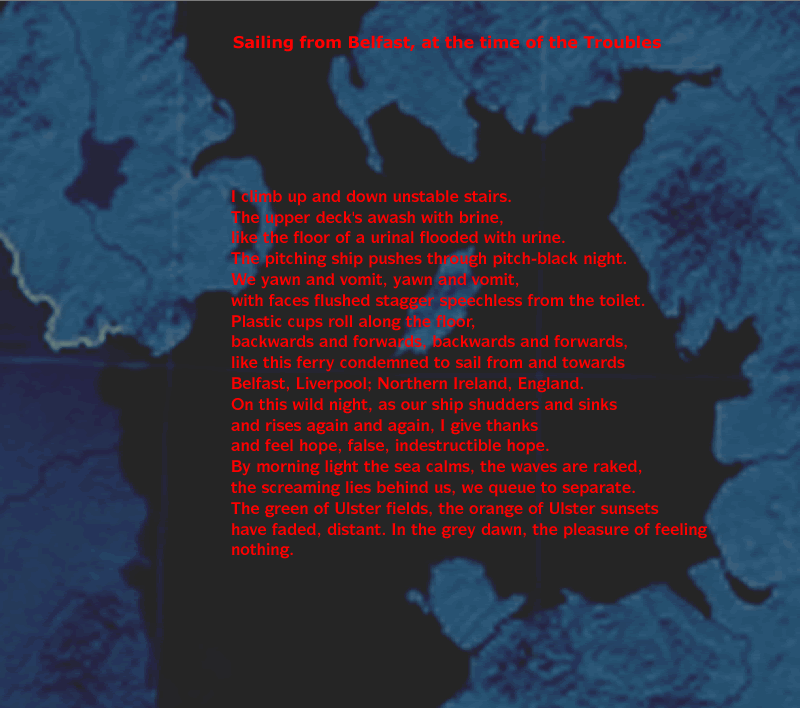
and
in fragmented form, the fragments attached to the picture space, which has
three regions, the Irish Sea, Ulster and Liverpool.
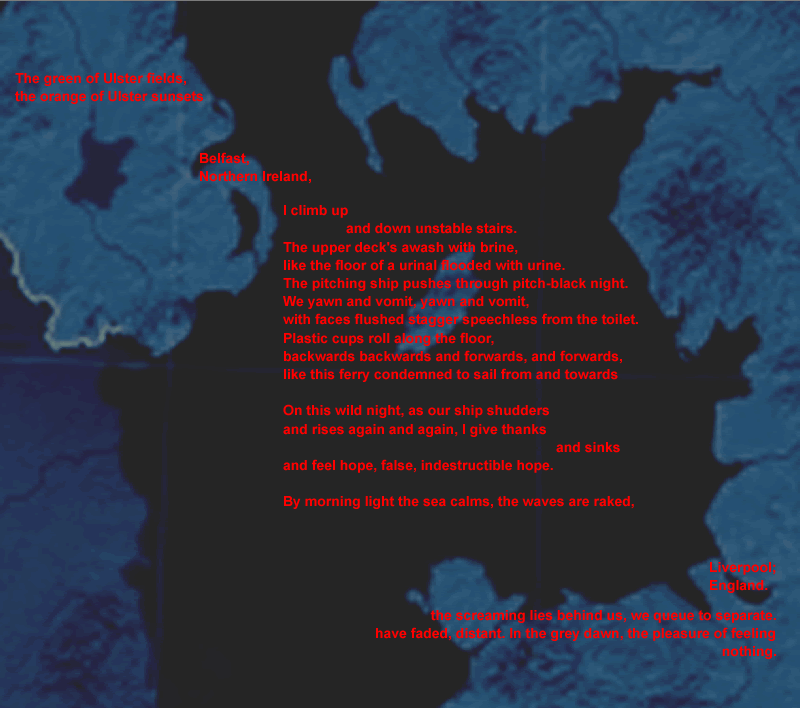
An
animation
shows the process of
fragmentation and the process of reading the fragmented poem.
Almost all poetry so far
has been in what I refer to as matrix form - the usual way
in which a poem is printed, as a continuous block of lines. Lines or parts
of lines can be freed from their position in the matrix - this is fragmentation
of the matrix - and arranged in picture space.
Concrete
poetry and text-design should be natural, instinctive forms rather than the
result of intense theorizing. Intense theorizing can come later, if need be.
A writer with visual interests looks at, let's say, a mountain and a village
in the valley beneath the mountain and has something to say about the mountain
and the village. What could be more natural than to place the words not in
the usual setting of the poem, what I call the 'matrix,' in continuous lines,
but where they belong in the picture space - the words about the mountain
near the mountain and the words about the village near the village, lower
down? This is 'attachment,' attaching words to where they belong in the picture
space.
Another
example of fragmentation and attachment:
The sky vaults
over soaring hills
gradually falling
into the darkness at their feet,
and resting between the hills, the sun.
The sun slipping from the grasp of the sky, growing
smaller and smaller.
Rocks still glowing there,
and here a stream gargling.
Birds still dashing around,
still masses and masses of light,
ducks ducking on the pond,
no life in the least unhappy.
The air still warm,
the colours of the flowers still warm,
in the garden by the pond,
and the sun, marigold orange, slowly turning
deep geranium red,
set in its ways.
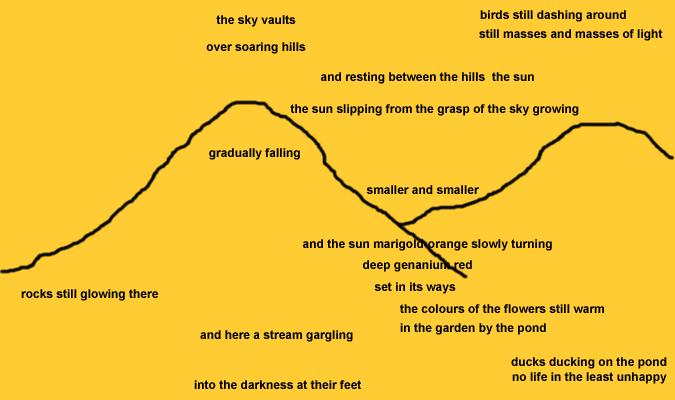
Words
can be attached too to parts of a non-representational composition. Here,
there's more freedom of action in placing the words in the picture space.
The designer may take account of considerations which are familiar to artists,
such as balance, proportion, deliberate use of imbalance and disproportion,
arrangement of masses along horizontals, verticals and diagonals. This is
the practice of text design, which offers exhilarating opportunities.
All
this has important implications for the
{direction}
of a poem and the reading of a poem. The reading
of a traditional poem in matrix form is obviously simple: from the left hand
side of the first line to the right hand side of the last line. When a picture
poem or picture text is read, {direction} is more complex, as shown by the
eye movements of the reader when looking at the picture space. In the animation,
the complex eye motions are shown by the movement of the red rectangle. For
example, the first lines of the poem may be placed in the lower right hand
corner of the picture space. The next lines may direct the viewer to the lower
left hand side, to be followed by a shift to top right. There may be frequent
pauses, allowing time for concentrated attention on a single part of the picture
space and the words in that part of the picture space. Poetry and other texts
become less subject to time. (The non-temporal aspects of poetry and other
texts and the temporal aspects of visual art interest me very much.)
Mines
is another attachment poem, the lines being attached to an image
of the mine workings. Whale
isn't an
attachment poem. The words form the shaft of the harpoon rather than
being attached to an image of it.
Strata
poetry
An
example of strata poetry. My poem 'Mines:'
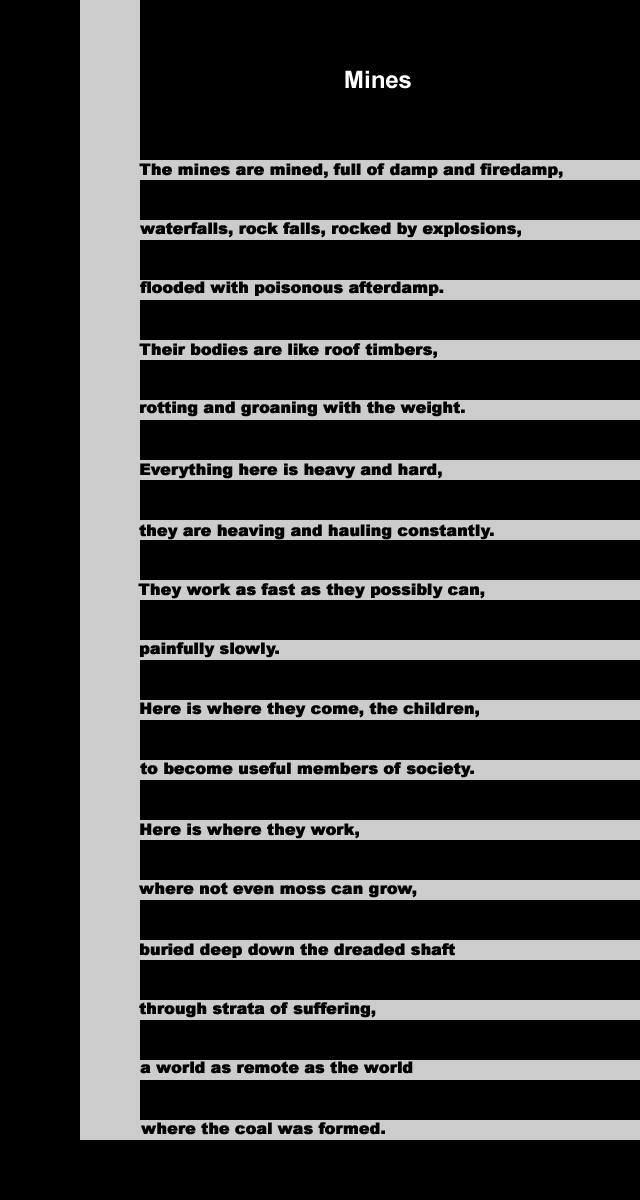
The
word 'mined' is a play on words and a reference to explosive mines used in
warfare - land mines, aerial mines and sea mines. The gas firedamp in mines,
mainly methane, is explosive when mixed with air. After firedamp has exploded
in mines, the poisonous gas afterdamp, made up mainly of carbon monoxide,
is formed. Children worked in mines in this country until the passing of the
Mines Act of 1942, which prohibited the employment of girls, women and boys
under 10 years old.
The
architect Frank Lloyd Wright had 'an obsession with strata of rock as an inspiration
for horizontal stratification in buildings' and a consuming interest in 'the
larger theme of "Nature" as a model for architecture.' (From the
fine review by William J. R. Curtis of 'The essential Frank Lloyd Wright:
critical writings on architecture' in the Times Literary Supplement.)
Poetry
has very often taken the larger theme of "Nature" as a model, but
I make use here of the linkage between strata and lines of poetry. In the
representational poem above, the strata are the seams of coal, the lines of
the poem are the low tunnels dug into the seams. The strata are also layers
of suffering, penetrating deeper and deeper into a world of almost unimaginable
harshness. Concrete poems are often playful, sometimes no more than technical
exercises, sometimes as trivial as doodles, but I see every reason to use
concrete form for the most serious ends.
It
shouldn't be thought that I oppose industrialism or think that the industrial
revolution was a false turning in human history. Quite the opposite. The industrial
revolution inflicted a vast amount of avoidable suffering, unavoidable suffering,
and has spared vast numbers of people in later ages the suffering which is
inevitable when nature is insufficiently controlled. Our age, which is very
much aware that nature can also be controlled far too much, would not benefit
overall if this progress were reversed and we had to live in a state of nature,
life, in the words of Hobbes, 'nasty, brutish and short.'
Faulting
in poetry is a technique which can be applied to the line-strata. Poem-faulting
has a linkage with geological faulting: layers of rock are fractured and a
block may move vertically downwards. In the same way, in faulted poetry some
or all of the lines are fractured and a block moves downwards, so opening
up the interior of the poem, with significant effects upon poetic texture.
In
a poem with an appreciable number of lines and with lines of appreciable length,
there's zoning,
the contrast between the border region and the interior.
Words deep in the interior of a poem may be denied their full force. Faulting
opens up the texture of the poem. The challenge is to ensure that the faulting
of the lines is the result of emotional, poetic force.
Punctuation
and festive lights
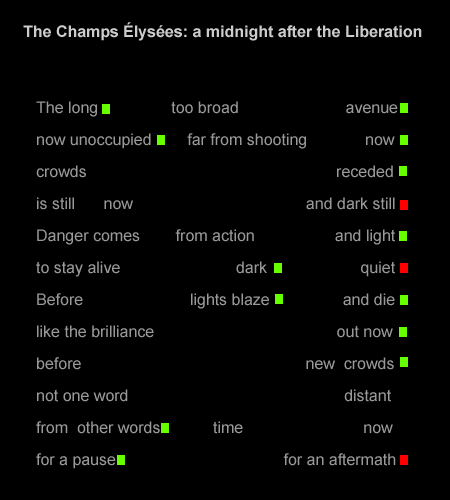
The
patterning which is characteristic of concrete poetry is achieved by the arrangement
in space of words and lines.This is probably a unique example of further patterning
by punctuation. Full-stops ('periods' in American English) are shown as small
red blocks and commas are shown as small green blocks, to give the effect
of festive lights which are in tension with the sombre grey text and black
background and the sombre diction. In this period immediately after the liberation
of France from Nazi rule there's austerity but also very much to celebrate.
The
poem is an example of
pulse poetry
as well as concrete poetry.
Colour
effects
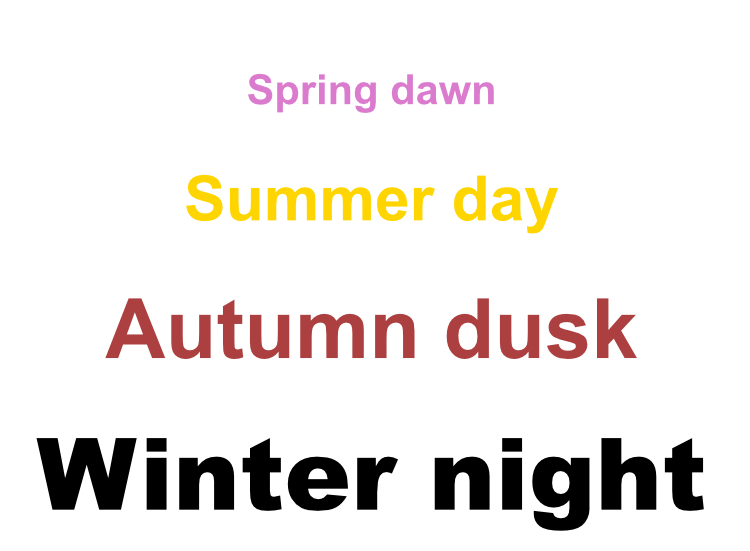
The lines of this poem of mine show
linkage by
meaning. There's progression in the
poem which is dual: the seasons on the left, times
of day on the right. The poem is obviously very simple, or deceptively simple.
It offers the reader the literary equivalent of psychoanalytic 'free association,'
'a method of exploring a person's unconscious by eliciting...thoughts that
are associated with key words provided by a psychoanalyst.' (Collins English
Dictionary.) The poem obviously should not be read quickly. There has to be
time to summon up images, memories. The poem is pictorial in its use of colour.
The black of the last line, in the font Arial Black, represents, of course,
the winter night. Other appropriate colours are chosen for the other lines.
Transept
poetry
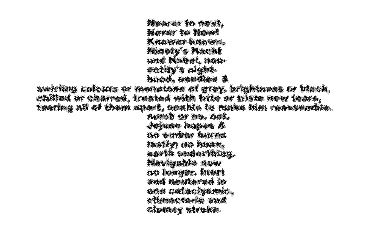
The example here is blurred deliberately, although some of the content can
be read. The content - which would require disproportionate space to explain
- is less important than the shape.
It
has the same shape as a cruciform poem such as the one by Roland Sabati but
that's the only linkage. For a reproduction of Roland Sabati's poem click
here.
It's
a fine design but it surely isn't a poem. None of the 'concrete poems' on
the page - some of them, again, very fine designs - are poems. Blake's illuminated
poem is a poem but not a concrete poem. I discuss differences between
poetry and non-poetry later.
Transept
poetry has a linkage is with the transepts of a church ('the wings
of a cruciform church at right angles to the nave.') Suppose you are in a
church with a very long, narrow nave. Walking along the nave gives a feeling
of spatial constriction but, when the transepts are reached, the feeling of
spatial opening. The feeling is well expressed by Nikolaus Pevsner, who describes
the interior of Ely Cathedral, including its unique feature, the Octagon,
in 'The Buildings of England: Cambridgeshire.' The Octagon is 'a delight from
beginning to end for anyone who feels for space as strongly as for construction.
For the basic emotion created by the Octagon as one approaches it along the
nave is one of spaciousness, a relief, a deep breath after the oppressive
narrowness of the Norman work.'
In
the reading of a transept poem there are similar contrasts in passing from
the narrow lines to the wide lines, and, also, in passing from the wide lines
to the narrow lines. The wide lines, the 'poem-transepts,' can be placed at
any point in the poem, at the top or bottom of the poem as well as in the
middle. The poem need not be cruciform in shape, although the example above
is cruciform.
Transept
poetry is an instance of poetry in which
line
length is important. On the linked page where I discuss this,
I write:
'Proportion
and disproportion are important considerations in the discussion of variable
line poetry, as they are in the discussion of architecture. The architectural
critic Alec Clifton-Taylor makes the point (in 'The Cathedrals of England')
that 'York nave is yet another English Gothic building which is too broad
for its height.' A literary critic may make the point that the short lines
in a poem of lines of variable length are too short in proportion to the long
lines, or that there is a disproportion in the number of shorter lines compared
to the number of longer lines. If, for example, the number of shorter lines
is insignificant, the contrast may be muted and ineffective. Proportion is
important in poetry as in architecture but this is not to say that poems should
always be well-proportioned. The deliberate use of disproportion is a valuable
technique. It can produce extreme, very modern effects.'
Axis
poetry
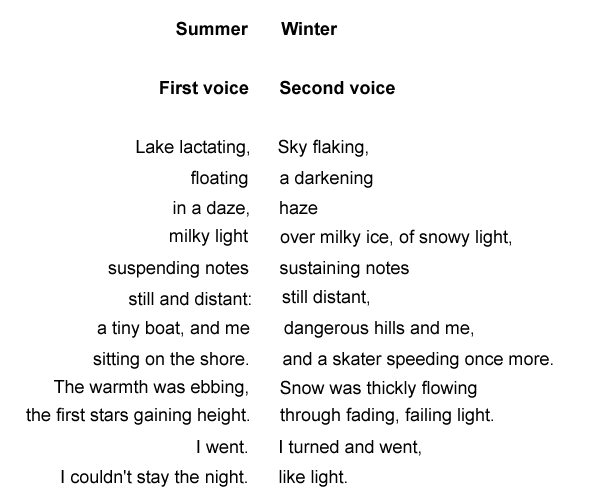
This
is the poem Derwentwater. There's a vertical axis
which divides the poem into two halves. A dictionary definition of axis (Collins
English Dictionary): 'a real or imaginary line ... about which an object,
form, composition, or geometrical construction is symmetrical.' Since axis
poetry gives shape to the poem on the page, it can be considered a form of
concrete poetry.
The
poem is read 'along' the line, preferably by two readers. The rhymes of the
two halves are 'along,' horizontal, but the grammatical sense is vertical,
'down' each of the two columns. Although the diction is plain and simple -
'milky' applied to light and to ice, for example - it's transformed by putting
the words and phrases in the two halves of the poem in close proximity. The
two halves obviously show strong contrasts of theme - summer and winter -
but there are also subtle contrasts of syntax and punctuation, for example,
'still' in the half-line of the first voice, 'still and distant' is different,
grammatically, from the 'still' in the half-line of the second voice next
to it, 'still distant.'
The
layout of things far removed from poetry underlies the axis form. Consider
a simple set of mathematical equations and the way in which the equations
are laid out on the page, or a set of linkage statements in the notation I've
devised and the way in which these linkage statements may be laid out on the
page, the linkage brackets < > in a vertical line. The contents and
linkage brackets are left blank in this illustrative example.
a = c
- b
b = 2
c = 4
a = - 2
[ ] < > [ ]
[ ] < > [ ]
[ ] < > [ ]
Lines
of poetry can be laid out on the page in a similar way. The poem is divided
into approximately two halves, left and right. There are linkages between
the lines on the two sides.
Centred rhyme
can also be considered as a form of axis poetry. In this case the axis is
horizontal and the two halves of the poem are upper and lower.)
What
linkages may there be along a vertical axis? There are various possibilities.
These are only a few:
A space
generally shows the position of the vertical axis. The organizing
principle which links the left side of the line and the right side
of the line and which is, as it were, placed in the space, may be no more
than a pause, the space being the visual counterpart of the
pause. The pause is a development of the caesura. The caesura
is generally applied in an informal way, the space-pause in axis poetry is
applied in a systematic way, and is presented in a systematic way on the page.
The result is a series of split lines. James Dickey employed split lines in
his poetry, sometimes with one space in the line, sometimes with more than
one, presenting the spaces unsystematically, without a vertical axis. An excerpt
from James Dickey's 'The Firebombing:'
Slants is woven with wire thread
Levels out holds together like a quilt
Off the starboard wing cloud flickers
Another
possible organizing principle is equality, the linkage being
with the equals sign in equations like the ones above. There can't, of course,
be strict equality. Mathematically, equality may indicate that the expressions
on either side of the sign have the same reference. This can be implemented
in lines of poetry, the left side of the line having the same reference as
the right side of the line.
Other
organizing principles are conjunction and disjunction.
Disjunction - disconnection or separation - is suited to many different contents:
opposing views, sharply contrasted views, but also a dialogue between different
minds, of the kind found in Yeats' 'A Dialogue of Self and Soul,' or in his
'Ego Dominus Tuus,' although the form generally demands more succinct statements
than in either of these. Like the other organizing principles, disjunction
can lead to poetry which transcends the organizing principle, to a poetry
which is not at all abstract. Consider this very clear and, in fact, systematic
example of disjunction, even if the disjunction isn't shown along a vertical
axis, from Shakespeare:
CRABBED
Age and Youth
Cannot live together:
Youth is full of pleasance,
Age is full of care;
Youth like summer morn,
Age like winter weather,
Youth like summer brave,
Age like winter bare;
Youth is full of sport,
Age's breath is short,
Youth is nimble, Age is lame;
Youth is hot and bold,
Age is weak and cold,
Youth is wild, and Age is tame:—
Age, I do abhor thee;
Youth, I do adore thee:
O! my Love, my Love is young!
Age, I do defy thee—
O sweet shepherd, hie thee,
For methinks thou stay'st too long.
Constellation
poetry
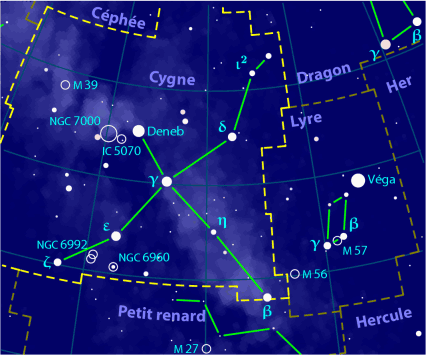
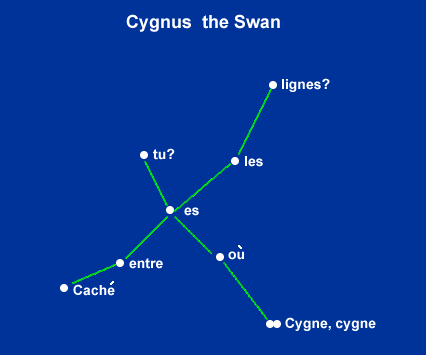
Constellation poetry uses images of star constellations as an organizing principle.
Each word (or syllable) is attached to a star. One of the concrete poems I've
written in this form is in French, 'Cygne,' Cygnus The Swan. The word 'Cygne'
is repeated. The star to which the repeated word is attached is a double star,
a primary and a companion star. (Patrick Moore: 'probably the most beautiful
object of its kind in the whole sky.)
Cygne,
cygne
où es tu?
Caché entre les lignes?
A literal
translation, which doesn't preserve the sound linkage between 'cygne' and
'lignes,'
Cygnus,
cygnus
where are you?
Hidden between the lines?
There's
an obvious allusion, in French, to the English 'reading between the lines.'
In
rhyming 'cygne' with 'lignes' here, I break the 'rule' in French verse which
forbids the rhyming of a plural with a singular, unless the singular ends
in 's.' Roy Lewis has a good section on this rule and others in his 'On Reading
French Verse: a study of poetic form.'
Licence
given to me to make use of the first image of Cygnus in this section requires
me to insert this notice:
Copyright (c) 2010 Paul Hurt
Permission is granted to copy, distribute and/or modify this document under
the terms of the GNU Free Documentation License, Version 1.3 or any later
version published by the Free Software Foundation; with no Invariant Sections,
no Front-Cover Texts, and no Back-Cover Texts. A copy of the license is included
in the section entitled
"GNU
Free Documentation License".
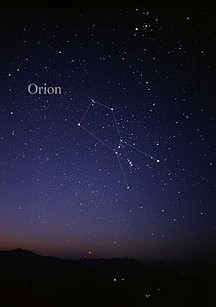
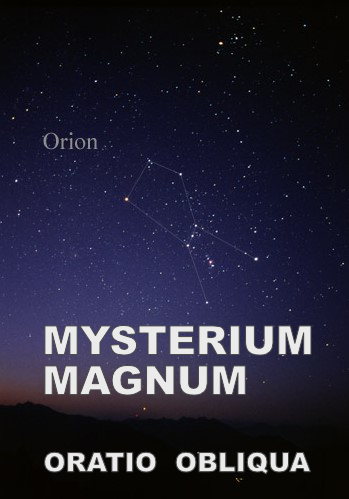
The Latin phrases have been quoted and used often
in publications in English. Each word has a close linkage of sound and meaning
with a word in English:
Mysterium
- mystery
Tremendum - tremendous
Oratio - oration, speech
Obliqua - oblique, indirect
I use
the three stars in the centre of the Constellation which have much smaller
magnitudes than the other stars as a punctuation mark ... Without showing
line endings:
ORION
MYSTERIUM
TREMENDUM . . . ORATIO OBLIQUA
The title
is part of the concrete poem: there's a sound linkage between 'Orion' and
'Oratio.'
Rudolf
Otto discussed numinous experience in his influential book 'Das Heilige,'
translated as 'The Idea of the Holy.' He wrote that 'Mysterium tremendum,'
the 'Tremendous Mystery,' is an aspect of the numinous, which can have a linkage
with belief in God, gods, the holy and the transcendent. Many non-believers
have found the idea of the numinous important and have given it a non-religious
interpretation - as I do myself.
The English
composer and poet Ivor Gurney wrote from the trenches that he 'illicitly walked
under the stars, watching Orion and hearing his huge sustained chord ... through
the night.' (Quoted in Geoffrey Hill, 'Collected Critical Writings.')
'Oratio
obliqua' is 'indirect speech,' as in 'they said that the starry night was
numinous' rather than the direct speech of 'the starry night is numinous.'
The starry night has numinous power, but for me an oblique, indirect power,
which deepens its mystery.
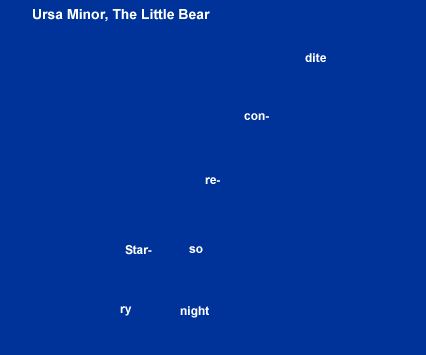
Starry
night
so recondite.
Here,
the syllables are short and show the position of the stars rather than being
attached. The syllables given particular emphasis (shown in bold print immediately
above) have the sound linkage of rhyme. These syllables show the positions
of the stars which have the greatest magnitude in the constellation of Ursa
Minor, alpha and beta - alpha is Polaris, the Pole Star.
The starry
night is described as 'recondite' as 'requiring special knowledge to be understood'
(Collins English Dictionary), or at least in one important aspect of understanding,
the special knowledge of astronomy.
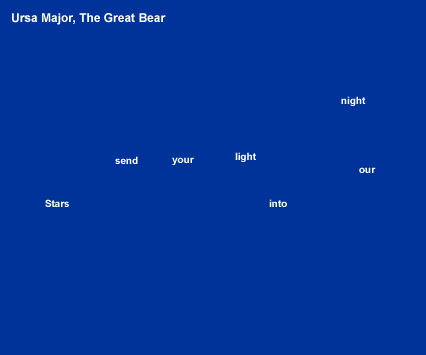
Stars,
send your light
into our night.
As the
word are short, I use them to indicate the positions of the stars.
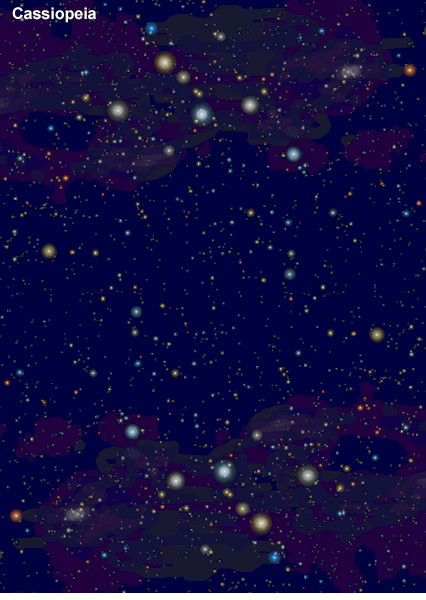
Cassiopeia
is the W-shaped constellation, here presented below its inverted form, the
letters 'MW' standing for
Milky
Way
The
Milky Way flows through Cassiopeia. I use the image to illustrate 'Innumerable,
tiny stars as beautiful as large stars.'
This
image is an instance of Text Design rather than Concrete Poetry.
'Anti-emoticons'

Concrete poetry shouldn't be a poetry of simpletons, for simpletons. A
concrete poem of any value should have far more sutlety and depth than an
emoticon, such as a smiling face or a sad face. Why do I claim that this is
a poem, and not just a poem but a far from simple poem? The title is
relevant: 'Anti-emoticons,' not 'Emoticons.' If the reader/viewer knows that
what seem to be emoticons are opposed in the poem, then this is at least a
start in the layering which makes for complexity. Admittedly, further
background information is needed to take the layering, the building of
complexity, further. This is one of those poems which require notes for its
full appreciation. This is the necessary background (from my page
The culture industry.)
'BBC1
News has been using graphic design in more and more obtrusive, more and more
ludicrous ways, in accordance with its guiding policy of progressive (or
regressive) infantilization. How much
longer before news of a better than expected inflation rate or a success in
English football is accompanied by the display of a happy, smiling emoticon
and news of a natural disaster or news from a war zone is accompanied by
the showing of a sad emoticon?
'The team of 'graphic designers' at the BBC already
has a repertoire of emoticons, primitive products of advanced
computer technology which spell out, in the most hackneyed way, what viewers
are expected to feel. BBC1 News, as well as showing the desperate and
grotesque state of the world shows too the desperate and grotesque state of
some sections of the media, such as the BBC itself.
'Bad news from a bank, bad news from the City of London -
this calls for dark and gloomy storm clouds above some typical high-rise
financial buildings.
'To show that someone is very newsworthy but under
pressure, that the news about the person is very important,
the film of the
person walking is slowed down, so that the person doesn't just walk
but walks with very, very significant steps.'
The poem can be written in straightforward text form, and this is
obviously it:
BBC
BBC
Some of the poems on this page are extended but this is obviously not one
of them. The text is ultra-minimalistic. It's a rhyming poem. The lines are linked
by sound and the sound is very similar in the two lines, but not,
despite appearances, identical. The principal difference is that the letter
'C' in the second line will receive markedly more emphasis.
Poetry is a monophonic medium, like works for solo voice or solo
instruments which aren't able to play chords, or which can produce chords,
but not in the movement or movements concerned, for example many movements
of the Bach Suites for unaccompanied cello and the Partitas and Sonatas for
unaccompanied violin. Most music is made up of more than one line, and the
various lines can be used polyphonically or with the emphasis on harmony,
for example a melody with supporting harmonies given to other voices or
instruments. This is a very great advantage in music. Poetry's {restriction}
to monophony is potentially a very great disadvantage. The disadvantage is
overcome by such devices as ambiguity, which in effect gives two or even
more lines - lines of meaning, that is - and the resonance of poetic
language, which gives 'poetic harmony' ('poetic harmony' understood not in a
hackneyed, sentimental way.)
Concrete poetry opens up remarkable new possibilities - poetic complexity
given by the interaction of word and image. If the words, whether part of a
line of poetry or not, are regarded as having a linkage with a musical
melody, the images can be regarded as having a linkage with an
accompaniment. Or the two elements can be regarded as having a linkage with
polyphony. In essence, they contribute to layering of the poem, which gives
opportunities for satisfying complexity.
Rotation of a letter in space opens up new opportunities in concrete
poetry. In 'Anti-emoticons,' the 'C' is rotated counter-clockwise through 90°
to give the smiling mouth in the upper image. This is rotated through 180°
to give the sad mouth. Emoticons are used to express, without any subtlety,
emotions such as approval and disapproval. The faces are used in this
standard way here. In the upper image, approval of the BBC, in the lower
image, disapproval. Obviously, anyone hoping to write concrete poetry or to
appreciate it should have an intense interest in the spatial dimension as
well as the verbal dimension. Simple rotations in space can be interesting,
even exhilarating,
In the section Letters: the wrong shape?
I
discuss some difficulties in using letters for design. A suitable choice of
font can sometimes eliminate these difficulties. The font 'Corbel' is used
for the letter 'C' in these images and gives a mouth of suitable shape. Most
other fonts would be unsuitable, for example, Times Roman. Arial Black is
used for the letter 'B.'
The section of the page The Culture Industry explains that the BBC has
been making increasing use of emoticons - not simple smiling or sad faces,
but images which are just as crude, and that I regard the trend with
disapproval. So I regard this as a tensile poem, with an apparent
contradiction. The poem is reflexive. A device is used to condemn a device.
An important question to be asked of any poem is, what kind of poem is
it? A poem shouldn't be judged by irrelevant criteria. Concrete poems are of
the most varied kinds, or should be. This is primarily a satirical or
sarcastic poem.
John Heartfield wasn't a concrete poet but his satirical and
sarcastic use of images, sometimes incorporating prose, can be strongly
recommended. (He was born in Berlin and changed his name from Helmut
Herzfeld during the First World War, anglicizing it in protest against
German nationalism and militarism.) Dawn Ades has a good section on his work in 'Photomontage.'
One
of the pieces illustrated is John Heartfield's 'Hurrah, the Butter is
Finished! '

Dawn Ades writes, 'Many of Heartfield's best jokes - which in being
funny lose none of their savagery - involve a literal translation of Nazi
rhetoric. So, in Hurrah, the Butter is Finished! (19 December 1935), the
text at the bottom gives a quotation from a speech by Goering: 'Goering (in
his Hamburg speech): "Iron always makes a country strong, butter and lard
only make people fat." ' So Heartield shows a family chewing obligingly on
iron ...' Even the baby in its pram and the dog are eating articles made of
iron.
Concrete poetry: renewal
Introductory
comments
The basics: elements and composites
Questions to ask
Success
Activism and politics
How not to theorize
Songs and opera
The prestige of poetry
Poetry and non-poetry
''Concrete music'
Beyond poetry and prose
Letters: the wrong shape?
Poems on this page
Faulty
'linguistically innovative poetry
Poems on this
page
Compartments of the mind
Faulty 'linguistically innovative poetry'
In praise of 'concrete poets'
Eugen Gomringer, Marcel Duchamp, Handel
Introductory comments

stevecadman's photostream
This is obviously not a poem, but a very strong and
successful design, making full use of a property of the two different
word-lines: they are equal in length, 'British' and 'Library' each having
seven letters. I argue that concrete poems often owe their success to their
design, not to any poetic content.
This
is an outspoken account - in part. I argue that
-
'concrete poetry' is
a misleading name for most of the works that claim it.
-
practitioners and commentators
have generally forgotten to ask the basic question: is this particular concrete
work any good? Instead of honest artistic evaluation,
{substitution}:
manifestoes and theory.
-
although theorizing
about literature is a completely legitimate activity, a significant amount of 'literary
theory' is routine verbiage and the name 'theory' is a completely misleading
name for many of the works that claim it: its application to concrete poetry,
as to other branches of poetry, is mindless. Even good and interesting theory
can be misapplied.
-
in general, the claims
made for the social and political effects of concrete work are delusions,
although delusions which are often creditable to the practitioners or commentators
holding them.
-
in general, this field,
a fascinating and important one, is in need of basic, healthy criticism.
Concrete poetry is neglected by most writers and readers of non-concrete
poetry. It's neglected in a different sense (like a neglected
garden or farm) by some of the writer/designers and commentators who work in it.
But the
criticisms I make are intended to be friendly, not hostile, as the section
In praise of concrete poets makes clear.
Although
a great deal of what follows is established and familiar, I often provide
new concepts, such as 'regions of the poem,' for poetry as highly organized
form. Things which are established and familiar are far from being beyond
dispute. As anyone familiar with the field will know, there are disagreements
about so many of its aspects. I think that the fairly systematic approach
I use, particularly in the section 'The basics: elements and composites,'
may help to clarify some things. I'm far from having an aversion to theory.
My approach is unlike any other because it makes use of the ideas in {theme}
theory which I've evolved and which are explained in the page
Introduction
to {theme} theory. This is the reason why some terms, such as
{separation} and {direction}
above are enclosed in curly brackets, and the term
{theme} itself.
All the
same, everything here can be understood without any knowledge of the background
in theory. I use the theory very sparingly and in a non-technical way. Despite
my strong interest in theory, my starting point here is my own practice in
concrete poetry. Although my approach is quite systematic, it's far from being
comprehensive and detailed. I explain my own views but I give little indication
of the very diverse views and activities of other practitioners. So,
{restriction}
is applied.
I emphasize
the need to 'place' the concrete poem or 'concrete poem,' to evaluate it,
but not as a whole. There's the need for {separation} of the two elements
of design and language. One element may be much more successful than the other.
Non-concrete poetry is 'placed,' nobody with the least interest in poetry
(or informed interest in poetry) supposes that all poems are on the same level. There are better and worse
poems, poems of permanent interest and very slight poems. The need for evaluation
of concrete poetry is very often overlooked. The poetry or 'poetry' of concrete
forms is given exemption, which is a
form of {restriction}.
I discuss
the problematic nature of the letters used as elements of design. Here, elements
which have a primary function, conveying meaning, one they perform very successfully,
are given a completely different function, as a primary contributor to a visual
design. Whenever a thing with a primary function is given another function,
problems may arise.
The
basics: elements and composites
Concrete
poetry and the kind I think is misnamed, 'concrete poetry,' are both
composite
forms.
In the
case of concrete poetry, the elements linked in the composite are design and
poetry:
[design] < > [poetry] to give design-poetry form
or poetry-design form (the two aren't synonymous.)
In the case of 'concrete poetry,' the elements linked are (1) design (2) words
and/or letters: words-design or letters-design form.
(Again, not synonymous.) Anticipating a conclusion, I think that the elements
aren't usually even approximately equal. The
{ordering}
is important and the element given more emphasis ({prior-ordering}) is placed
second in the convention I use. In this section I make comparisons with other
composite forms: song and opera, words-music form - this
includes poetry-music form - and with a hypothetical form
which is very instructive, 'concrete music' (not to be confused with the established
school 'musique concrète.') 'Concrete music' is music-design
form.
Questions
to ask about the elements and the composite
-
Are the elements compatible?
Is the form possible at all?
-
If the form is possible,
is the linkage so difficult to achieve that the creation of works in the
form is problematic?
-
Are the elements linked
regarded as equally important?
-
Are the elements linked
in practice equally important?
-
Are the elements in
a particular composite more or less equal in their artistic success or is
one element obviously much stronger artistically?
-
If so, does the relative
artistic strength of one element, the relative feebleness of the other,
significantly lessen appreciation of the composite work?
-
Are the criteria for
appreciating an element not linked with another element in a composite suitable
for appreciating an element which is part of a composite? For example, should
the poetry which is part of a concrete poem be judged by the same criteria
as other poetry? (If, for example, the poetry of concrete poetry is far
more likely to be whimsical than a poetry of depth and profundity, how should
we respond? Should whimsical poetry be regarded as an important kind of
poetry or a very minor form?)
-
How suitable are letters
and other elements of written language for use in a design? Are their shapes
suitable or obtrusive and unsuitable? Are some letters much more suitable
than others?
Success
The
artistic success of composite forms as of non-composite forms is surely a
very important consideration. The overcoming of technical problems and ingenuity
aren't enough. If someone succeeds in carving a complete poem on a very small
pearl to create a kind of sculpture-poem then we can admire the achievement,
but we still have to ask, is the poem any good? (The critic Martin Seymour-Smith
wrote of the 'shallow ingenuity' of the British playwright Tom Stoppard.)
The provision
of a manifesto and the social and political idealism of some works in concrete
form - these and similar considerations aren't enough either. The page
{substitution}
contains a long but not complete list of factors which are often
used as a substitute for evaluation. I acknowledge the importance of these
secondary factors whilst insisting that they can't possibly be used as a substitute
for evaluation.
Although
the language element of concrete poetry hasn't been evaluated at all adequately,
it has probably been evaluated to a greater extent than the design element.
There are comments on the general inadequacy of the language of 'concrete
poetry,' for example Roberto Simanowski's comment that 'experimental poetry
- which concrete poetry is part of - has been accused of being an autistic
language...' In his lecture,
Concrete
Poetry in Digital Media he quotes one of the 'selves' which have very
different attitudes to the digital media: 'There are many spectacular effects
people program in digital media. If they only would find some meaning to hook
on to it! But they can't think of any because they are programmers not poets.
They have an idea of how to make an action happen on the screen but no idea
of what this action could mean. They flex their technical muscles ... But
they have nothing significant to say.' This is a general difficulty, with
a vast range of examples, not confined to the {separation} between the technical
and the emotional. To give just one example, the {separation} between the
skills of growing and cooking. People who have the skills to grow crops of
superb quality may not have the skills to cook them in anything but an unimaginative
way - or the time and energy needed to grow these crops may not leave enough
time and energy to cook them well.
The 'poetry'
of 'concrete poetry' isn't usually poetry at all. A more truthful description
of the writing would sometimes be 'concrete jottings' or 'concrete scribblings.'
Even
so, the design of concrete jottings or scribblings may well be very successful, an artistic achievement.
As for myself, more often than not, I'm very impressed by the design element
of 'concrete poetry.' It's rare that I find a design which I think is abysmal.
A very
good case could be made for considering the design element of 'concrete poetry'
as more important than the language element, for the inequality of the elements,
although I think that the majority of creators (or 'practitioners') wouldn't
agree. Because I place the emphasized element second, my own view is that
'concrete poetry' is generally a words-design form, not a design-words form.
Marjorie
Perloff writes that 'in the 1980s and 90s, the going view, especially in Anglo-America,
where concrete poetry had never really caught on, was that the 1950s experiment
in material poetics was ideologically suspect - too "pretty," too
empty of "meaningful content," too much like advertising copy. In
the university, this estimate still prevails. To this day, one would be hard
put to find an English or Comparative Literature department that offers courses
in concrete poetry. Doesn't the subject belong more properly, if at all, in
the art department, my colleagues ask, specifically in courses on graphic
design?'
The last
point is a valid one. A course on graphic design would seem the most suitable
place to study most existing 'concrete poetry' but an art has a future (in
most cases) as
well as a past and present. A renewal of 'concrete poetry' could give us an
art very different from graphic design.
The other
points are largely invalid. 'Ideologically suspect' is a very careless phrase
- according to which particular ideology or ideologies? Very important works
of art have been 'ideologically suspect.' "Too pretty" is limiting.
Attractiveness and even beauty could have been considered at the same time.
The criticism that 'concrete poetry' is too empty of "meaningful content"
is wide of the mark. The content of the language element is reduced but usually
meaningful. The criticism could be equally well directed at non-concrete works
which abandon meaning to some extent or to a large extent. Some of these are
artistic failures, some are not.
Activism
and politics
In the
last section I mentioned the 'social and political idealism of some works
in concrete form' and claimed that idealism shouldn't be confused with artistic
success. In her intelligent and interesting and perhaps indispensable book (the
fact that it's difficult to obtain doesn't have any bearing on its indispensability)
'Concrete poetry - a world view,' Mary Ellen Solt writes of the Brazilian
Decio Pignatori that he 'makes an anti-advertisement from an American advertising
slogan, condemning both the culture that makes and exports coca-cola and the
culture that drinks it ... By simply exchanging the position of the vowels
in "coca" the poet gets "caco" ("shard"). With
this most economical method he is able to bring into the poem a most provocative
question: What will the archaeologist of the future be able to say about our
civilization if the shards we leave are fragments of coca cola bottles The
final, damning word of the poem "cloaca" ("filthy place,""cesspool")
also takes its letters from "coca cola."
This
is potentially commentary and analysis as a substitute for evaluation. As
a matter of fact, I'm very sympathetic to this criticism of the Coca Cola
Corporation. I've written about it myself, on a page which is concerned with
schools.
Activism
is something which concerns me a very great deal. I've written about it in
various pages on this site, amongst them the pages on
bullfighting,
the death penalty
and animal welfare. Constructive opposition
can be achieved by thought as well as action, as I make clear in a discussion
of campaigning techniques
in bullfighting. This cites the enormous impact of the penal
reformer Beccaria, who had none of the attributes of the practical activist.
I don't
think that typographic experiments can be similarly effective, as the scholar
Johanna Drucker claims for Dadaism, 'which was concerned with opposing the
established social order through subverting the dominant conventions in the
rules of representation.' What's missing here is a healthy respect for reality,
a healthy skepticism about the effectiveness of typography as an agent of
subversion. Roberto Simanowski comments on Johanna Drucker's claims, 'In this
perspective, the deconstructive play with the symbolic order of language is
considered to question social patterns and to even have revolutionary potential.'
In this country, a tiny Marxist splinter group used to put up posters which
had the heading, 'Preparing for power.' 'Preparing for political irrelevance'
and 'Preparing for political extinction' would have been a realistic statement
for this particular group. A claim for the revolutionary potential of 'the
deconstructive play with the symbolic order of language' is no more realistic.
Just as unrealistic is the claim, made by Derrida, that 'South African apartheid,
which some dull analysts had blamed on a tenacious and fearful white minority,
was actually brought about by phonetic writing.' (Felicia Marronez, commenting
on 'Postmodern Pooh' by Frederick Crews, a book about the intellectual mediocrity
of so much postmodern thought. Sandy Starr comments that the book is intended
to satirise '...the kind of critical writing that academics and students generally
come up with today - evasive, incomprehensible, and making enormous, unjustified
claims for the power of texts and language.')
In his
comment, Roberto Simanowski is simply stating and interpreting the views of
Johanna Drucker. In general, he states difficulties fairly and openly, as
in this comment: 'Experimental poetry - which concrete poetry is part of -
has been accused of being an autistic language and therefore of being incapable
of having an impact on the reader's consciousness. Thus, concrete poetry seems
to be useless in terms of political interventions.' A vast range of linkages
is revealed if this last phrase, 'useless in terms of political interventions'
is given restatement in terms of
{modification}.
If P is 'political interventions,' ~ 
 P
P
In a
later section, I quote from the page
design
principles. One thing may have more than one function,
but it may be that it's far better at performing one function than others.
In the case of poetry and writing-design, there's not just one obvious function
but a range of functions. Even so, I think that poetry and writing-design
may be quite poor, or not the best choice, for some functions which are often
allocated to them. Poetry can be used for social and political protest but
it's usually not the best or only way of making social and political protest.
It may be difficult to combine protest with other 'functions' of poetry, such
as expression of complex emotion.
My concrete
poem Whale
is intended to be a protest.
I very much believe in protecting these magnificent mammals: 'Save
the whales!' Even so, the opening lines, 'whale/chase/whale/chase/whale/chase'
with their pounding rhythms convey, I hope, the visceral excitement of pursuing
the whales, even as I condemn the act. Compare the lines I quote above:
Be
happy, be contented, be unsatisfied, be many.
Feel the ecstasy of the hunter,
the terror of the hunted,
the anger of the one who acts to stop the killing -
but of course, so rarely can.
Later,
I'm sure that the poem makes amends by conveying the poignant death of the
whale, the bringing of the magnificent animal to 'frail/death.' Non-activist
poetry, poetry which mentions but makes no criticism of the chasing and death
of an animal, can be justified because it performs so well its primary function,
conveying such emotions as rapturous excitement, as with the remarkable passage
in Wordsworth's 'The Prelude,' beginning at line 425 (1805 edition) and which
includes the lines:
...woodland
pleasures, the resounding horn,
The pack loud bellowing, and the hunted hare.
So through the darkness and the cold we flew,
Writers
in concrete forms, like typographers, who oppose an abuse shouldn't suppose
that poetry or typography is automatically the best way of opposing it. Conflicting
claims and paradox are surely essential to contemporary literature. It shouldn't
be supposed that 'activism through literature' will be at all straightforward.
How
not to theorize
The claim
of Johanna Drucker in the previous section illustrates, I think, a faulty
relationship between theory and the concrete - by which I mean not the concrete
poem but the world of events, facts, reality. (I certainly have the philosophical
sophistication to be aware of the challenges to such views of reality, to
common-sense views of the world, from, to give just one example, Berkeley.)
These claims belong to what I call the word-sphere.
Of course, the word-sphere
is the natural home of imaginative writers. This isn't a pejorative use of
the term. 'Word-sphere' in the pejorative sense refers to evasion, to faulty
{substitution}. The word-sphere is often used to evade reality. Reality is
very often difficult, intractable, sometimes defeating any attempt at {modification}.
It's far easier to arrange words so that words become a substitute for action,
so that words deflect attention from the lack of action. This is the world
of ringing declarations and facile claims. It offers a more congenial home
than reality. The word-sphere is the natural home for ideologists even when
action in the world isn't an issue, avoiding the need to come to terms with
uncomfortable facts.
What Daphne Patai and
Will H. Corral, the editors of 'Theory's Empire,' have to say about theory
is very well expressed: 'these theories aren't really theory but
approaches...Terms such as "approaches" or "perspectives"
don't suggest the scope, explanatory power, or level of generalization one
expects from a theory. Most theory anthologies and guides to the practical
application of Theory, do not address the incoherence of their use of the
operative term.'
Theories
of concrete poetry, all literary theory, should have a linkage with scientific
theories (but not by being 'scientistic:' there are vast differences between
the world of the natural sciences and the world of literature.) In science,
theory plays a completely healthy, indispensable part. Theory has a very close
linkage with concrete observations and experimental results. Science has no
use for theory as free-floating, in a sphere of its own, autonomous, unrelated
to the reality of observation and experiment. 'Uncomfortable facts' in science
are regarded as very important and are not evaded. At the same time, successful
scientific theory, such as the kinetic theory which explains the concrete
event of steam lifting the lid of a kettle, is very abstract.
If my
discussion here of these very extensive issues seems so brief as to be
inadequate, I'd reply that the rest of this site offers examples of argument
to do with the linkages between theory and non-theoretical reality.
Songs
and opera
Concrete poets and 'concrete poets' should be encouraged by the fact that there are
many musical masterpieces which have as an element in the composite language
vastly inferior to the music in quality, language which is sometimes banal
or ridiculous. It's doubtful if many of them will be encouraged.
Concrete
poetry/'poetry' is generally concise and not dramatic. Its conciseness is
part of the reason it can't be fully dramatic, in the sense of theatrical
drama or operatic drama. Aristotle was right, I think, to demand of dramatic
works what he called  'megethos,' 'substantial size.' Perhaps concrete poets/'poets' will create
massive, dramatic works in the future, but it's very unlikely. Opera has some relevance to concrete
forms, but as an extended, dramatic form not nearly as much as song. There
are song cycles but songs are generally concise.
'megethos,' 'substantial size.' Perhaps concrete poets/'poets' will create
massive, dramatic works in the future, but it's very unlikely. Opera has some relevance to concrete
forms, but as an extended, dramatic form not nearly as much as song. There
are song cycles but songs are generally concise.
Every
great or good opera has, I think, a libretto much less great or good. The
librettos of Mozart's librettists, Lorenzo da Ponte and Emanuel Schikaneder,
have literary and dramatic virtues, but they are eclipsed by the drama-music
of Mozart in 'The Marriage of Figaro,' 'Don Giovanni,' 'Cosi fan tutte' and
'The Magic Flute.' Placing the emphasized element second, opera is a words-music
form.
On the
other hand artistically ambitious song, including the 'Lied,' often uses very
substantial writers as the language element in the composite, for example
Schubert's use of Goethe, Benjamin Britten's use of Hölderlin and Thomas
Hardy. But no matter what the literary gifts of the writer, I think that the
collaboration is an unequal one. Anyone with no knowledge of German and no
translation of the words would miss a great deal by listening to a setting
of a poem by Goethe or Hölderlin but not the most significant part of
the experience. This is because the musical element has prominence in this
particular form: words-music rather than music-words form. It isn't because
music is 'superior' to poetry.
Factorization
and an adequate survey are needed to do justice to this matter.
Music has some very significant restrictions, such as weakness in representation.
Popular
song uses language which is often mediocre. Often, the music is as mediocre as
the language but very striking, artistically successful songs seem able to
soar above the mediocrity - or worse - of their words. I like very much
America's 'A horse with no name' but the language set to music is mediocre or
rank bad - eg,
'the heat was hot.' There are impressive, evocative fragments in popular song.
I admire Sting's 'fields of barley, fields of gold' and Joy Division's 'love
will tear us apart again.' Is there continuous poetry in very good popular
song at the same high level as the music? I don't think so. The continuous
poetry of Joy Division's lyrics, for example, is mainly doggerel, far below
the level of the music. (Deborah Curtis gives all the lyrics in her excellent
'Touching from a distance: Ian Curtis and Joy Division.')
The
prestige of poetry
Outstanding
concrete poetry, like outstanding popular music, can incorporate doggerel.
Outstanding 'concrete poetry' can incorporate abysmal writing. But 'concrete
poets' want so much to incorporate poetry, not non-poetic 'writing.' Why?
Surely memorable or beautiful fragments are quite enough? 'Poetry,' though,
has such prestige - real prestige and justifiable prestige. (I like very much
the poetry of Mark Waldron, who works as an advertising copywriter, writing
the words for adverts. I'd be very much surprised if he finds this work vastly
more important and prestigious than his poetry. It's certainly far more highly
paid, but I think that outside poetic circles as well as within them, to be
a poet or to be involved with poetry confers some prestige.)
Although
fragments can convey such piercing insights, can be so memorable, many 'concrete
poets' are likely to want nothing less than fully organized poetry, even when
the thing itself is unattainable for them. I return to this matter later.
Poetry
and non-poetry
If
concrete poetry (unlike 'concrete poetry') contains 'real poetry' (not
necessarily great or good poetry) then it's essential to distinguish poetry
from the non-poetry which is claimed to be poetry. This, of course, is a very
big undertaking. Here, I argue for certain criteria. Anyone, 'concrete poet'
or otherwise, who says that poetry can be almost anything written, or that
poetry is whatever the poet claims to be poetry, or that the poetry which
is linked with design is completely different in kind from the poetry which
is not linked with design should be expected to argue the case in detail.
Although the view is far less common now that poets are the 'guardians' of
language, poets should surely not be happy if words are used to mean anything
convenient to the user, particularly the word 'poetry.' Poets should obviously
take a great interest in the meaning of the word. Recommended: some study
of the Austrian writer Karl Kraus and his concern for language and misuses
of language, irresponsible use of language.
This
page contains, of course, prose and poetry. I could change the width of the
column which contains the prose discussions and explanations and the result
would be exactly the same prose. Nothing essential would have been changed.
The arrangement in space of poetry, on the other hand - arrangement on the
page or poster or computer screen - is the result of a conscious decision
by the poet. I'm in agreement here with Christopher Ricks, in his important
essay 'Wordsworth: 'A Pure Organic Pleasure from the Lines.' (Essays in Criticism,
volume 21, 1971.) He writes 'Eliot had come up with a very suggestive formulation:
'Verse, whatever else it may or may not be, is itself a system of punctuation...'
Christopher Ricks continues, 'The punctuation of which poetry or verse further
avails itself is the white space. In prose, line-endings are ordinarily the
work of the compositor and not of the artist...'
'White
space' is an essential term in design, including graphic design, but Christopher
Ricks doesn't pursue this linkage. I do. Poetry, unlike prose, has a linkage
with design in that the arrangement in space of words is fundamental. The
compositor who alters the arrangement in space of prose alters nothing fundamental.
The compositor who alters the arrangement in space of poetry (except for matters
such as font and text size) does alter something which is fundamental.
This
is to give particular
weighting
to a structural criterion not to style or diction.
By this criterion, prose poetry - for example the 'prose
poetry' of the French writers Aloysius Bertrand and Isidore Ducasse, Comte
de Lautréamont - is misnamed, named by a long-standing tradition certainly
in need of examination and criticism. 'Prose poetry' is set out as prose and
despite any use of poetic diction it should be called 'poetic prose.'
To focus
attention on one aspect of diction. To a far greater extent than prose, poetry
uses concentrated diction. But if by long-standing tradition,
aphorisms,
which are also highly concentrated in diction, had been referred to as 'aphorism
poetry,' then this would have been misleading. The only 'aphorism poetry'
is actual poetry, poetry with the structural characteristics of poetry which
also has some of the characteristics of aphorisms such as the conveying of
a piercing insight.
But
there are difficulties with the structural criterion, with its reference to
lines and to white space. Christopher Ricks doesn't refer to these difficulties,
but they are substantial. What of those poems made up of 'chopped-up' lines,
poems which are surely misnamed prose? What of writing set out as prose which
obviously contains iambic pentameters and which should have been set out as
poetry?
The writer
should be driven to find expression in prose or poetry. The prose or poem
form should not be a wilful, sometimes arbitrary and sometimes misguided choice
of the writer. What kind of language should find natural and obvious expression
as prose and what as poetry, with their significant differences of arrangement
in space?
I'm in
agreement with those who stress the levels of organization lacking in prose.
(This isn't at all to grant automatic artistic superiority to the form with
the more varied levels of organization - far from it.) Prose has the phrase,
the sentence and the paragraph as important levels of organization. Poetry
has these - although not always the verse paragraph. For my discussion of
the relationship between phrase and line in poetry, see
sectional
analysis. It has in addition the line and a fundamental level
of contrast achievable in various ways, for example by rhythmic contrast,
syllabic contrast and a form I sometimes use,
pulse.
Is the breaking down into poetic lines of rhythmically contrasted, syllabically
contrasted or pulsed language always necessary or not? I think it is. Each
line, consisting of small contrasted units - the metrical feet, the syllables,
the pulses - is then contrasted with other lines, to give the highly organized
form, the poem.
There
are other possible aspects of poetic organization. I've developed, such as
regionality and zoning,
as a further aspect of poetry, but not of all poetry. What I call 'region
poetry' has a relationship between boundary region and interior region which
can't be achieved in prose. The poem can be linked - distantly - with a higher
organism, which has different levels of organization: sub-cellular particles,
the cell, the tissue. the organ, the organ system.
The most
obvious visible feature of the poem is the arrangement in space of lines,
but other features are also prominent, although not in all poetry. In some
poetry they are well hidden. Many poems have rhythmic contrasts which are
very muted, although this isn't necessarily an objection. Very subtle contrasts
may be acceptable or far more than acceptable. The obvious thumping rhythms
which were popular in the past are often felt now to be crude, with good reason.
To focus
attention on the obvious visible features again, I'd agree with the claim
that all poetry which isn't misnamed has a certain structure which is linked
with arrangement in space. In this sense, all written poetry
has a linkage with concrete poetry but not all poetry is concrete poetry.
The concrete poet goes further than the non-concrete poet in space-arrangement.
The poet may take account of considerations which are familiar to artists,
such as balance, proportion, deliberate use of imbalance and disproportion,
arrangement of masses along horizontals, verticals and diagonals. The poet
may be a conscious designer in two-dimensional or three-dimensional space,
'concrete poets' as much as concrete poets. Why then do I deny to 'concrete
poets' the claim of 'poetry?'
The arrangement
of elements in space is a necessary but not a sufficient criterion.
I think that the elements which are arranged in space have
also to be taken into account, not just the arrangement of the elements. I
think that not all elements are valid. There has to be a {restriction} on
these elements. This matter is central to my disagreement with many views
of what makes a poem a concrete poem.
The common
view is that elements can have any degree of fragmentation or
reduction down to the level of the individual letter. If
the designer takes care to arrange individual words or letters in space with
an aesthetic end in mind, then the result is a concrete poem. I can't agree.
Arrangement in space at the level of the individual word or letter is not
enough to make a concrete poem. When fragmentation or reduction is carried
too far, something essential (essential to what makes a poem a poem at all)
has been lost. A linkage with Chemistry: if the compound water is reduced
to its elements hydrogen and oxygen by electrolysis, we no longer have water.
A linkage with organisms. Earlier, I compared a poem with a multicellular
organism. An organism converted into fragments is no longer an organism.
I next
give more musical analogies and then argue for linkages between these musical
examples and concrete poetry.
'Concrete
music'
What
makes music - music? An elementary mistake is to claim that music has to have
'melodies, tunes.' Music - and often very great music - permits elements with
a very high level of fragmentation. These fragmentary elements can be given
enormous rhythmic impetus, can be the source of satisfying variation. Very,
very often, a classical exposition section which gives melodic themes uses
fragments of these themes as the basis of development in the development section.
A well-known example: the first four bars ('measures' in American English)
of Beethoven's 6th symphony ('The Pastoral') present a melody. A fragment
of this, not a melody as such, in bar or measure 2 plays a prominent part
in the development section.
There
are other mistaken views of what is essential to music other than melody.
These need only be mentioned. The key system isn't essential to music. In
one very influential branch of music, tonality was abandoned. Most music continues
to be based on intervals no smaller than a semi-tone, but a greater degree
of reduction is possible: 'micro-tonal' music.
Music
can be performed in varied ways: not only the human voice and conventional
instruments but electronic synthesizers of one kind or another. However, music
need not be performed to qualify as music. Someone with musical training can
read a musical score and hear the sounds internally. But even if the work
is never actually performed, it has to be potentially performable. I would
claim that a piece which is not potentially performable is not music.
Although
notes in a musical score are arranged in space, the arrangement in detail
- not, for example, the 'levels' which show pitch - is the work of the 'compositor'
not the creator, or would-be musical designer. Consider a hypothetical piece
of the hypothetical new form 'concrete music,' called 'Diamond Sonata.' 'Concrete
music' is very different from the established form 'Musique Concrète.'
Musique Concrète, originally developed by the French composer Pierre
Schaeffer, makes no reference to design in space. It's a musical form which
starts with 'concrete' sounds and arranges them into compositions. The contrast
is with music which gives a composition using musical notation and then has
the composition performed, the dominant ordering in Western music.
In 'concrete
music,' the music-design form, the arrangement of notes is the work of the
musical designer, not the compositor. This piece is 'Diamond Sonata.' It has
a minim (American 'half note') at its centre. The other notes are crotchets
(American 'quarter notes.') I make no claims at all for this design. I use
it simply as an illustration.

This design could be performed, but only just. Most musicians would consider
that a performance would be pointless and artistically meaningless. (Musicians
of the John Cage school might disagree.) How to perform it? The minims and
crotchets have a time relationship - the minim is twice the length of any
crotchet. The notes have no pitch level specified, but this is not an objection.
In musical scores, percussion instruments of indeterminate pitch are given
a notation using conventional notes. There are no indications of dynamics,
but we assume that the larger the note, the louder the sound. The performance
takes place, then, when the musician in the centre sings or plays a note louder
than the notes played by 8 other musicians, who play or sing notes louder
than the ones sung or played by a further 8 musicians. The notes played by
the musician in the centre is twice as long as the notes of the 16 others,
who sit or stand in the positions indicated by the plan.
It will
be obvious that although the design is very poor, it has more importance than
the musical content. The notes in this design act almost entirely as marks
on paper, with only the most limited reference to musical meaning. Marks with
no musical significance at all would convey the essentials of the design.
Although
a few composers have spatial considerations in mind, these are never more
than a subsidiary element. The work of the Polish composer Panufnik makes
explicit appeal to spatial considerations. Antony Hopkins has a good discussion
of one of Panufnik's works, 'Sinfonie di Sfere,' in 'Understanding Music.'
He writes that the purpose which Panufnik had in mind was 'to write a work
that would reflect in musical terms a sense of geometrical pattern and order...'
'Panufnik
visualized the symphony as a sort of journey through ...three spheres, ascending
through Sphere I to Sphere III...although music is normally (and properly)
regarded as a temporal rather than a spatial art-form, he wanted to search
for a new dimension of space through musical experience, a gradual penetration
into what he describes as the 'soul' and the 'body' of the spheres, the 'soul'
being the poetic content and the contemplative thought lying behind the notes,
the 'body' being the 'chain of altering and recurrent feelings experienced
through the framework of the musical material.''
As this
explanation proceeds, I think it becomes clearer and clearer that Panufnik's
purpose is close to 'Programme music,' music with an extra-musical context.
The context is usually not at all a musical deduction from the piece and is
sometimes wilful. Music is intrinsically non-programmatic, non-representational.
A performance
of the Panufnik symphony takes place in time. It seems impossible to exclude
time from music. I attended a recorded performance at an art gallery of 'Spem
in allium' by Thomas Tallis. Loudspeakers were arranged in the gallery space,
one speaker for each of the vocal performers. The performance, of course,
was temporal as well as spatial.
Non-concrete
poetry and music are both temporal. The linkages between them are close. Non-concrete
poetry may not be performed but it's potentially performable. Concrete poetry
is potentially performable. Is the same true of 'concrete poetry?' It's usually
performable potentially, even when the poetry uses a level of fragmentation
below the level of the individual word - letters, if not punctuation marks.
An avant-garde performance can be imagined in which a speaker in the centre
says simply the consonant 'c,' a speaker to the left says the vowel 'a' and
a speaker to the right says the consonant 't.' The temporal order would be
all important, of course. Successive deliveries from left to right would give
the meaningful 'cat.' Simultaneous deliveries would give rise to something
without meaning. This is not necessarily an objection. Poets who use unfragmented
words and sentences are sometimes content to abandon meaning - as, sometimes,
John Ashbery. Marjorie Perloff writes that he abandons meaning without achieving
any 'special intensity.'
'Abandonment
of meaning,' is not necessarily to abandon poetry. 'Special intensity' can
be misinterpreted. Compare taste. There are people who can only appreciate
very highly spiced food, food of 'special intensity,' ignoring a world of
subtleties, understated notes.
Beyond
poetry and prose
I think
there's a need for a new name for the language which is often used in 'concrete
poetry,' although not just in 'concrete poetry.' This language doesn't have
the sentence form of extended prose and doesn't have the distinctive organization
of poetry. It's neither prose (P) nor poetry (P) and so I call it 'non-PP
form.' More often than not, it's a language of fragments. These are none the
worse for being fragments. Fragmentary language and fragmentariness in general
interest me a very great deal. I think that they're crucial to an understanding
of contemporary life, thought and art. Italo Calvino writes in his essay,
'Knowledge as Dust-cloud in Stendhal' '...fragmentariness concerns not only
the past: even in the present something that is only glimpsed involuntarily
can have even more powerful effect...' (Translation by Martin McLoughlin.)
But my discussion here of fragmentariness has to be fragmentary.
One demand
can be made of the fragments which are so often a part of 'concrete poetry.'
This is for what I call
semantic
force and semantic significance, which involve the conveying
not only of intense experience but significant experience which lacks obvious
intensity. If all the the words of the words-designer are banal, without any
semantic force or significance, then the design element may well be successful,
but not the words. It's difficult to give semantic force or significance to
any level of fragmentation below the level of the word. Empty space and human
silence can be potent. It's more difficult to give semantic force or significance
to fragments than to these. (But see my
criticism
of Eugen Gomringer's 'Schweigen' below.)
Letters:
the wrong shape?
This
site has a substantial section devoted to gardening. It includes the page
design principles.
There,
I discuss things such as carpets which have a primary function but can be
put to other uses: one-many design. An object with only one
use is an example of one-one design. The first part refers
to the object or structure, the second part to its possible functions. Carpets
can be used not just for covering floors but for an outdoor use in gardens
and allotments, suppressing weeds by light starvation. All the same, they have
disadvantages for this use. They are heavy and cumbersome. There are problems
of disposal. An object which is well adapted to its primary function may not
be nearly so well adapted to a secondary function.
My 'dual-purpose'
text is a successful example of one-many design, I think. One object, text,
can have more than one function. It can be used to give information, or to
convey things that are more than information. It can also be used for navigation,
as on the page Poems. By clicking
on the text, the user is taken to the top of the page. Similarly for images,
which have a primary function, such as providing information or enjoyment
and other possible functions, such as navigation in a Web page. By clicking
on a poem in image form, the user is taken to the top of the page
Poems.
What
about letters and other objects of written communication? Their primary function
is semantic, to convey information and things that are more than information
in the distinctive setting of written communication. Using letters and other
objects of written communication for visual design is problematic. Are they
really multi-functional, capable of being one-many design elements?
The
lines which are used in drawing are capable of almost endless variety in their
length, shape, emphasis and placing. The lines which are letters and other
objects of written communication are subject to severe {restriction}. The
particular shapes of so many letters aren't particularly suited to general
design. Many of them have projections, are bulbous. The shapes can be subjected
to {modification} so that they are more suitable for the purposes of a particular
design, but obviously the {modification} is subject to {restriction}. After
a certain point, the letter becomes unrecognizable as the letter.
Some
letters are well adapted to general purpose use as 'design marks' such as
'l' in the font Verdana. Sans-serif fonts are far better adapted than Serif
fonts, but no matter what font is used, many other letters are far less suited
as 'design marks,' such as a, b, d, e, g, h, k, y, z.
'z' is
made up, in this font, of two horizontals and a diagonal. So, at the micro-level
of this element, we have the visual statement of two horizontals and
a diagonal. This may or may not be well integrated with the macro-level: let's
say, a design which makes particular use of verticals. Similarly, 'p' and
'b' in Verdana are both made up of a radial component, approximately circular,
and a straight-line vertical, not very prominent in this font. Again, integration
into the macro-design may be successful or not. The macro-design may contrast
ellipses with very pronounced verticals.
In most
cases, general 'marks' are far easier and more straightforward to use than
letters, unless letters are grouped to form a block or some other shape. Even
then, the block or other shape is bound to have irregularities which will
be obvious. But to state these difficulties isn't to present an overwhelming
case. Overcoming difficulties - triumphing over difficulties - is part of
the aesthetic challenge. In fact, there are many word-designs where these
seemingly unpromising language-elements are put to very good use in the design.
Poems
on this page
My own
work in concrete forms is essentially unfragmented. Even the poem
Sailing
from Belfast turns out to be completely performable in its fragmented
form and the spoken fragmented poem is very similar to the spoken unfragmented
poem, the poem in matrix form. There are obviously more
pauses. The fragmented poem is a transform
of the matrix form.
George
Herbert used forms for his concrete poetry which don't differ from the forms
of his non-concrete poetry. Now, the vast majority of concrete poems are examples
of free poetry. It's mistaken, I think, to regard free form as the only possible
choice for a contemporary poet. I generally use the term 'organizing principle'
instead of form. I think that established organizing principles such as the
sonnet and the rhymed couplet ('proximate lines linked by sound') can be used.
There are completely new organizing principles which can also be used. I use
organizing principles in my concrete poetry which I discuss on this page,
such as unit form,
strata form and
axis form.
Compartments
of the mind
I'd stress
{separation} between words with meaning and the visual design. My own practice
leads me to think that the two elements come into being from very different
compartments of the mind.
My own
concrete poetry, like my poetry in general, is more often than not bleak,
harrowing, discordant, but not at all a distorted view of life according to
any adequate ((survey)), I think. But whenever I design, I turn again and
again to serene and harmonious forms, not forms which are cluttered, agitated
or discordant. One strong influence is architectural, including the architecture
of the Italian Renaissance: forms such as the rounded arch, but
the arch uncluttered by polychromatic decoration. In her superb 'Germany:
architecture, interiors, landscape, gardens,' Christa von Richthofen writes,
'Sometimes German architects simply misunderstood Italian ideas, or used them
only superficially. Often Renaissance decoration is only added to the façade
of a building, and the brilliant clarity, the Italian feeling for rhythm and
harmony, balance and restraint are lost.' 'Rhythm and harmony, balance and
restraint' are what I aim at instinctively in design. Another influence has
been the architecture and all the varied designs of the Bauhaus, These and
their precursors represent, I think another renaissance, a renewal of purity
of design after the dominance of cluttered design in Germany and in other
countries, such as this country.
My
appreciation, though, belongs to yet another compartment of the mind. The
villages and towns of Alsace, anything but pure in their architecture, are
amongst the ones I like very much - Colmar, Riquewihr, Kaysersberg and others,
situated in France but German in style, with all the disregard for 'rhythm and
harmony, balance and restraint.' Italian Renaissance churches have less appeal for me in
general than Gothic and baroque churches. ('Appeal' here relates only to
appearance, not function. Whether the design of the church has great appeal or
very little, the function of the church is the same, disastrously misguided,
based on a completely false view of reality, I think.) And I tend to
appreciate very much designs in concrete poetry which have all kinds of
'picturesque irregularities,' like the layout of those Alsatian towns and villages.
Faulty
'linguistically innovative poetry'
More
'advanced' work isn't always the more artistically successful work. This is
isolation of the more advanced and
{substitution}
ev-, unless the claim can be justified that a high degree of 'advancement'
is necessary for artistic success. Poets have sometimes chosen to describe
their work as 'linguistically innovative poetry,' for convenience regarded
here as synonymous with 'L=A=N=G=U=A=G=E poetry, poetry with no use for such
archaic and outworn forms rhymed poetry, or poetry with a readily grasped
meaning. I'd stress the importance of factorization, of an adequate survey,
a survey without undue {restriction}. The 'cutting-edge' language of 'linguistically
innovative poetry' is only one factor. It shouldn't receive isolation.
'Linguistically
innovative poetry' may also be:
rhythmically
inert poetry
emotionally backward poetry
politically innocent poetry (for poetry which has political content)
drab poetry
poetry with nothing to say
poetry as no more than technical exercise
routine 'linguistically innovative poetry'
poetry which misuses the word 'innovative'
Or it
may be the genuine thing, linguistically innovative poetry which is far more
than linguistically innovative.
In
praise of 'concrete poets'
Contemporary painting and work in other forms such as the installation and
more recent experiments - the list of these is very long- are often produced
by attention-seekers. They'll use whatever techniques and turn to whatever
subjects give them the most attention. Works which are attractive and
beautiful and works which are authentically ugly or uncompromising in their
lack of concern for mere appearance don't usually give them enough attention
or satisfy their craving. Attention
matters more to these people even than money, although the money often follows.
Decadent and diseased art is often very influential and very well rewarded.
The words
'decadent' and 'diseased' have to be rescued from misuse ('degenerate' is,
though, almost certainly compromised for good, made unusable for good by its association with
the 'Exhibition of Degenerate Art' of the Nazis.) A significant amount of
non-concrete contemporary art is decadent or diseased, and this isn't because
it's giving us new insights into decadent and diseased aspects of reality,
which any adequate ((survey)) has to come to terms with.
In his
book 'High Art Lite: British Art in the 1990's' Julian Stallabrass gives a
superb and very acute analysis of the malaise of modern art. He discusses
its decadence and disease but also the meagre inner life of the attention-seekers.
For example, 'In different ways, Hirst, Hume, Emin and Turk - and they reflect
high art lite as a whole - show that it is possible to continue making art
without an interior life.' And, 'Hirst has become a cipher for the expression
of average desires and fears, expressed consciously and without conflict,
and finally reduced to the status of a corporate logo...'
Suzi
Gablik, in her book 'Has Modernism Failed?' offers a very different but also
interesting analysis, one that's equally pessimistic and, I think, realistic.
I don't
discuss particular works here. I only record my appreciation for the many,
many works of 'concrete poets' which are distinctive, interesting, remarkable
examples of contemporary art and design. A great deal of 'concrete poetry'
does renew our feeling for beauty and attractiveness. Where it's obviously
not attractive or beautiful - it may be exploring very different aspects of
reality - it has authenticity. The idealism very much in evidence in 'concrete
poetry' is welcome and refreshing. The fact that 'concrete poetry' has very
little market value compared with other forms of contemporary art in this
case works to its advantage. The fact that, despite any claims to the contrary,
it won't bring about social and political change is no argument against its
artistic value. There's almost no decadent or diseased or dehumanizing 'concrete
poetry. There are too many buildings in a fully contemporary style which are
dehumanizing. Contemporaneity, like ingenuity, isn't enough. Of course, it's
far easier for a small-scale form such as 'concrete poetry' than for a large
housing development to avoid these faults.
Eugen
Gomringer, Marcel Duchamp, Handel et al.
This
isn't to deny that are 'concrete poems' which aren't diseased or inhuman but
which aren't of much interest either. There are quite a number of them in
existence, a fairly pointless existence. The poems which are self-referring
but not much more than self-referring make up a significant proportion of
these - the kind of poem entitled 'squashed' or something similar and which
shows the letters as squashed, or the kind entitled 'snake' which has the
word elongated and snake-like in appearance. There's certainly a place for
playfulness but the playfulness of these poems gives, to me at least, only
the mildest kind of pleasure and the kind of pleasure which is, let's say,
far from inexhaustible. Even so, the context is important. Poems like these
self-referring ones can appeal very much to children. They can have an important
part in encouraging an early interest in poetry and design.
Eugen
Gomringer's poem 'Schweigen' of 1954 (German for 'to keep silent' or 'stay
silent') surely makes facile use of empty space and has an obviousness which
gives it a 'fairly pointless existence.' To avoid the need to link to another
site where the poem is displayed, I give the poem in my own lettering. The
design is so simple that this gives everything essential to 'appreciating'
the poem:
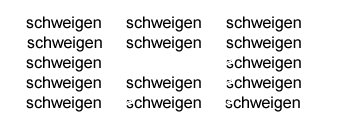
Eugen
Gomringer, from Switzerland, is often regarded as one of the founders of concrete
poetry, together with some Brazilian poets, Haroldo de Campos, Decio Pignatari
and Augusto de Campos, but George Herbert was certainly using concrete form
centuries before. Mary Ellen Solt in her fine 'Concrete Poetry: A World View,'
claims that he 'achieves the simplicity and purity of concrete art.' Surely,
simplicity and purity are achieved only by one element of the composite, the
design element. The composite as a whole is simplistic and grossly unbalanced.
An approximate musical equivalent for 'Schweigen' would be a note repeated
at the same pitch and with the same dynamics, with a long rest within the
musical texture. This would have simplicity and purity, but not at all inexhaustible
simplicity and purity. Beethoven had very high regard for Handel and made
the comment that Handel achieved the most wonderful effects 'by the simplest
means.' The means, though simple, were not nearly as plain and simple as in
this musical equivalent for 'Schweigen.' The miraculous effects he obtained
by simple means would include, I think, the opening of 'Zadok the Priest'
and the orchestral opening of the aria 'The people that walked in darkness'
from 'The Messiah.' These have nothing like the obviousness of 'Schweigen.'
These passages are part of a whole which is at a vastly more complex level
than 'Schweigen.'
'Simplicity'
should be subjected to
{resolution},
to make clear degrees of simplicity. I'd claim that only 'the more complex
simplicity' has artistic value. All-white canvases are too simple to have
artistic value, despite any claims to 'complexifying' effects such as minute
contrasts of tone and saturation, minute irregularities in the canvas.
Paul
Muldoon has written two similar, larger but no more complex and no more impressive
poems, both in his volume 'Hay.' One is 'A Half Door Near Cluny.' This is
the line making up the top edge and bottom edge:
stablesstablesstablesstables
In the
space inside the poem, unoccupied in 'Schweigen,' there's the word 'blé'
(wheat.)
The other
is 'The Plot.' This is the line making up the top edge and bottom edge:
alfalfalfalfalfalfa
In the
space inside the poem there's the word 'alpha'.
Eugen
Gomringer's poem can be acquitted of the charge brought against it by Marjorie
Perloff (generally a good commentator) following Caroline Bayard, who concludes
that 'the "fusion of expression and content" being advocated by
the Concretists was an instance of what Umberto Eco had termed the "iconic
fallacy" - the fallacy that "a sign has the same properties as its
object and is simultaneously similar to, analogous to, and motivated by its
object." At its most naïve "naturalizing" level, the iconic
fallacy manifests itself, Bayard argues, in poems like Gomringer's Silencio,
where the empty rectangle at the center of the composition is presented as
the equivalent to the "silence" conveyed by the verbal sign.'
This
is a mistaken view of the use of theory, in this case semiotic theory. Theories,
like the 'rules' of musical fugue or sonata form, can't possibly dictate the
artistic success of a poem in this way. If a composer 'breaks the academic
rules' of fugue or sonata form to create an artistically successful work,
so much the worse for the rules. No poet or 'poet' should have to worry about
infringing a codification of semiotics, despite its vast importance in understanding
works of art, as of so much else. The linkage between 'Schweigen' as absence
of speech or other sound and empty space is valid:
[Scweigen] < > [empty space]
If John
Donne had written concrete poetry like George Herbert, he could perhaps have
made a concrete poem using as a starting point the words from his 'Nocturnal
upon St. Lucy's Day, being the Shortest Day:' '...and I am re-begot/Of absence,
darkness, death; things which are not' and using a black rectangle at the
centre of the composition. This too would have been semiotically questionable.
Marcel
Duchamp's 'Succession' is less simple than Schweigen but simplistic all the
same and no more successful. 'Succession' has a kind of hole in the centre
too (both holes not nearly as good as the holes in Henry Moore sculptures),
but larger and not rectangular. The hole gains not the least aura of tantalizing
suggestiveness or bleak presence (or rather absence) by the words which surround
it, which include VOID and 'SILENCE...WORDS.' Most of the other words take
the form of similar antitheses, which will please people who are very easily
pleased, such as find real interest in the pairing of ' 'NIGHT...DAY,' 'PAST...NOW,'
'OFF...ON.'
Of course,
avoidance of simplistic-simplicity is no guarantee of artistic success. Many
of Apollinaire's 'Calligrammes,' are simplistically-simple, such as 'Il pleut'
but many have a clutter which amounts to a lack of integration. I think of
works such as 'La petite auto,' 'La mandoline l' oeuillet et le Bambon,' 'Madeline'
and 'Venu de Dieuze.'
Links
Nobody
would use this Web site mainly for its links. The links I give aren't comprehensive
for any section of the site. I write on the Links Page (which doesn't include
links to concrete poetry sites): 'There are many outstanding sites which I
appreciate very much, which I've studied carefully but which I haven't included
... as yet. ('Studied' is the word - very often, I've printed out many pages
from the sites, so that I could give them my full attention later.)'
The site
below gives a brief list of links, books and articles, which can be recommended.
Its links include such large and prominent sites as those of The Sackner Archive
of Concrete and Visual Poetry, UbuWeb and Michael P. Garofalo's site.(Although
these sites are very useful they're not critical.)
http://www.philobiblon.com/isitabook/bibconcrete.html
C. John
Holcombe's site 'Textetc' has a page on 'experimental poetry,' including concrete
poetry, which is highly recommended (and many other highly recommended pages
on many other topics). The page is critical. The author writes clearly
and well, he shows detached intelligence and refuses to be easily impressed.
It includes references and links:
http://www.textetc.com/modernist/experimental-poetry.html
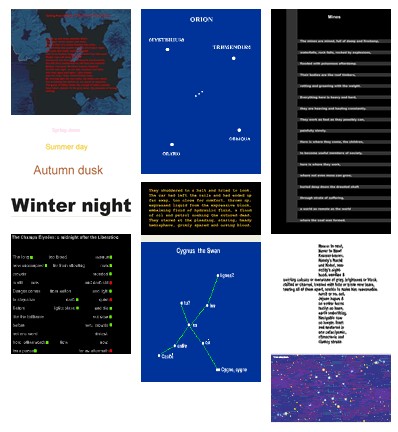




















![]()






